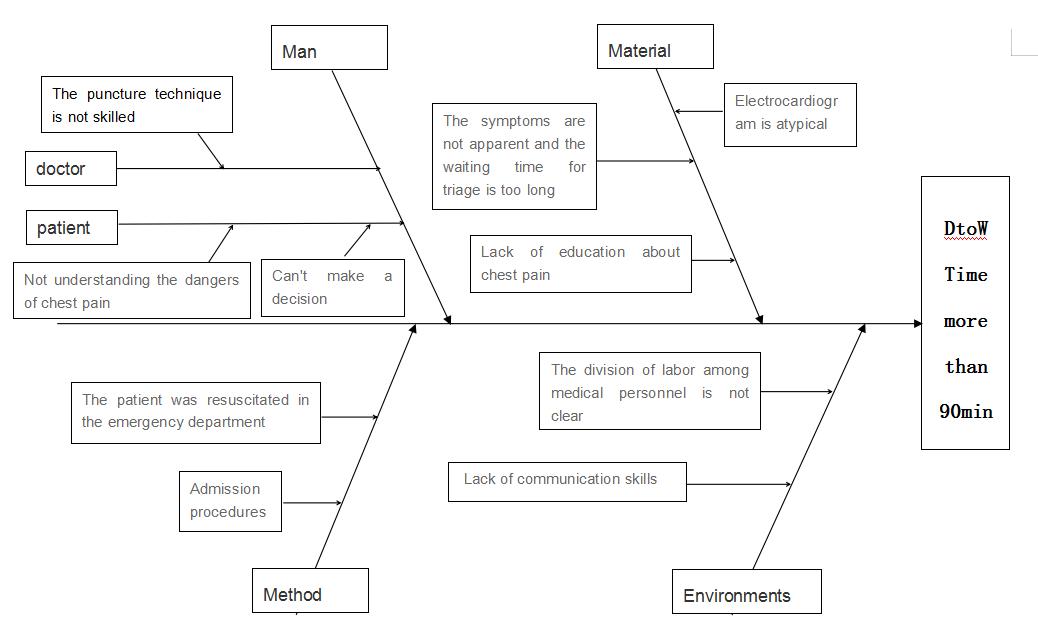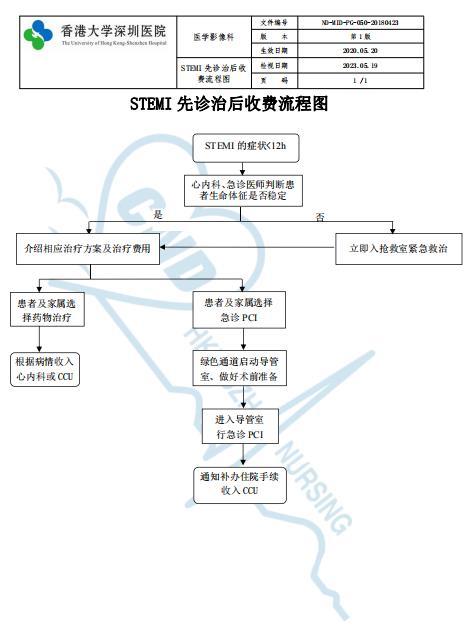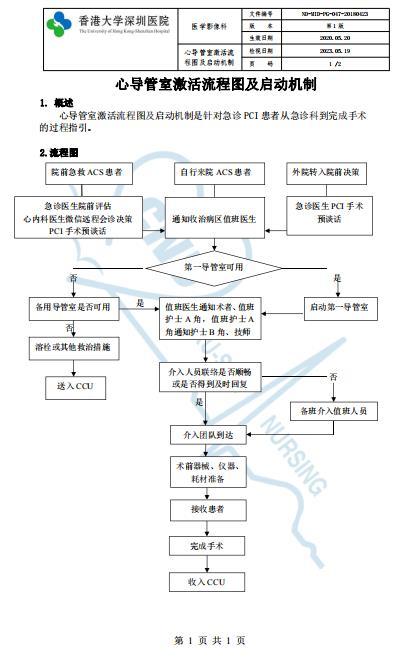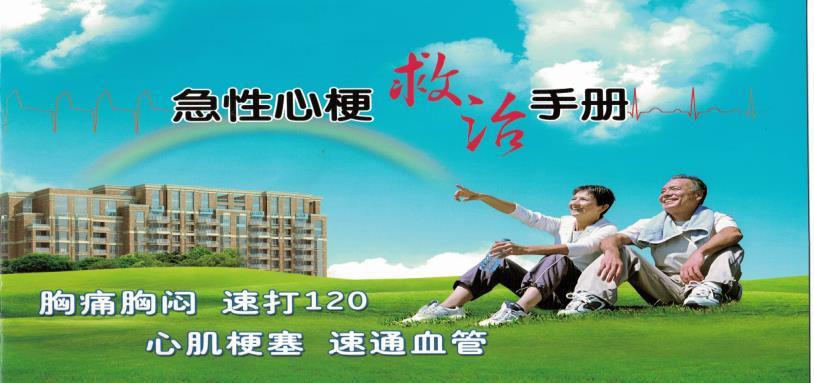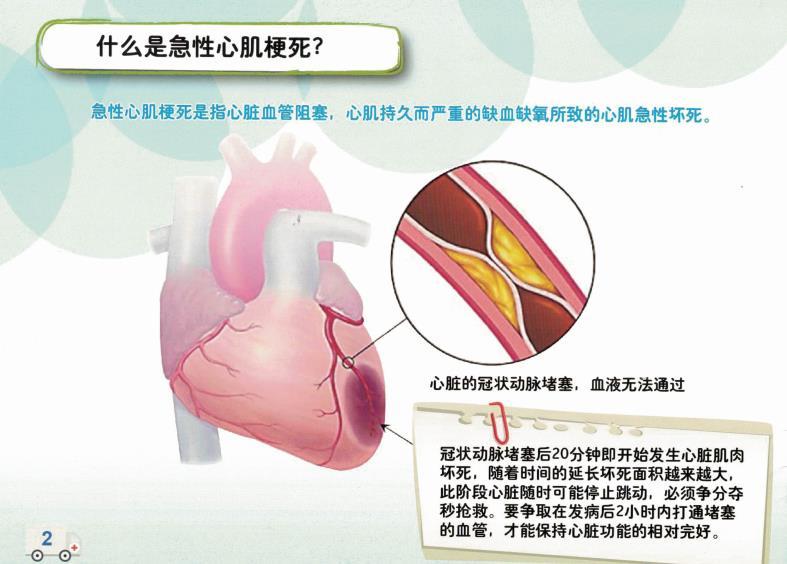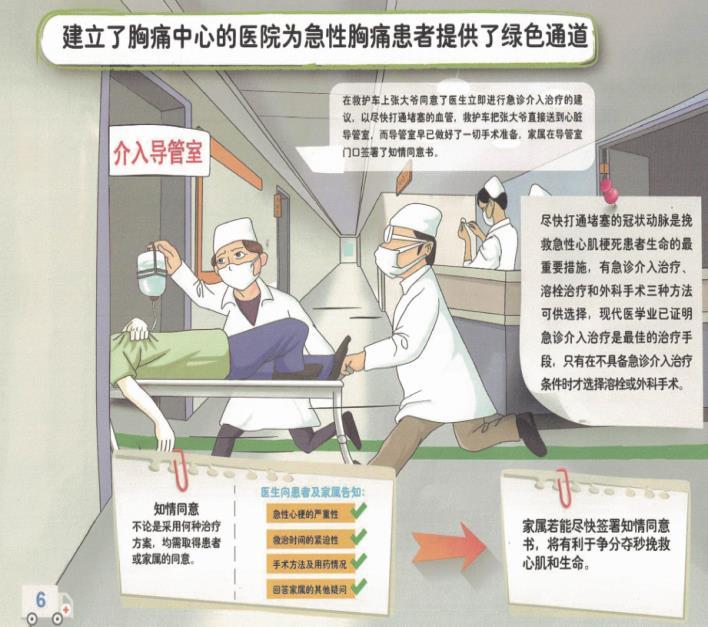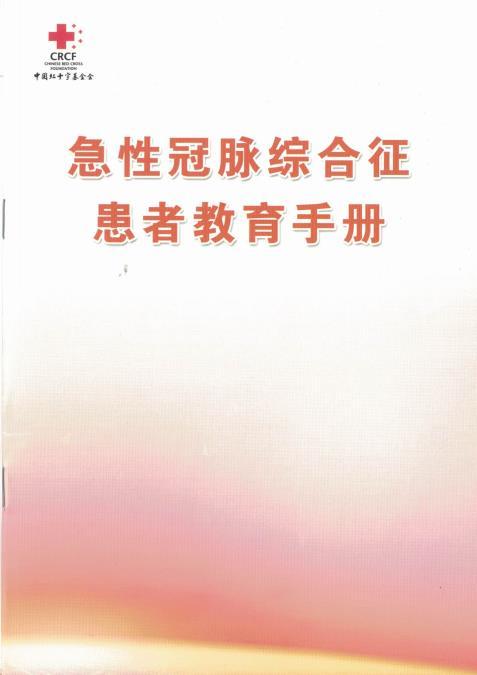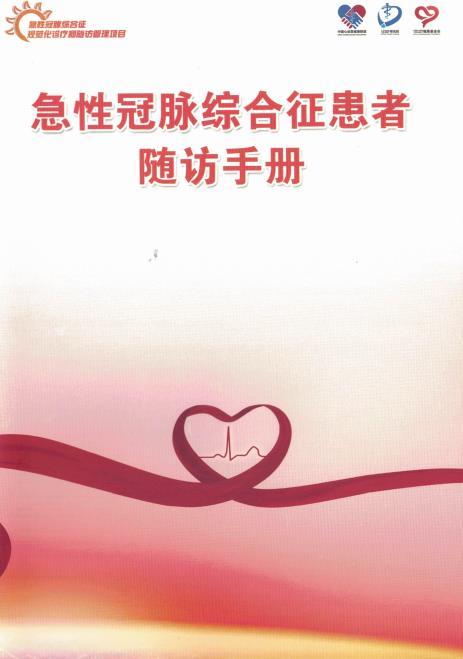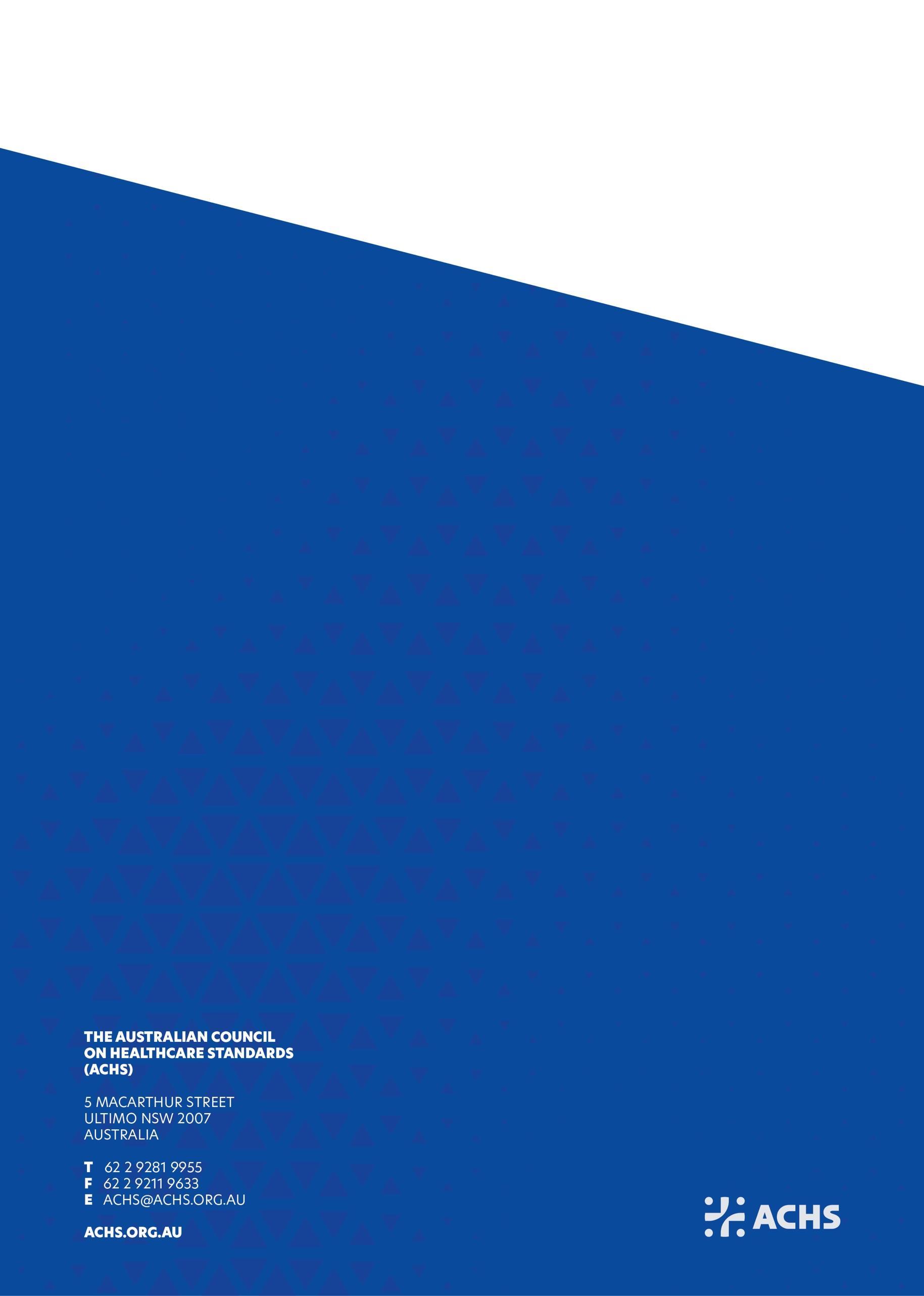Winner Submissions by Category

The 23rd Annual ACHS Quality Improvement Awards 2020
CLINICAL EXCELLENCE AND PATIENT SAFETY
Victorian Institute of Forensic Mental Health (Forensicare), VIC Thomas Embling Hospital and the Centre for Forensic Behavioural Science
Implementing an electronic instrument and clinical decision support system to predict imminent aggression and structure intervention to reduce aggression and the use of restrictive interventions
Tessa Maguire, Jessica Griffiths, Michael Daffern, James Ogloff, Brian McKenna, Chris Guest and Jo Ryan
Full submission page 5
NON CLINICAL SERVICE DELIVERY
Redcliffe Hospital, QLD Pharmacy Department
Drive Through Pharmacy Collections Minimising hospital visits for vulnerable patients
Michael Spargo, Ann Whitaker, Geoffrey Grima and Alysha Hoogendoorn Full submission page 26
HEALTHCARE MEASUREMENT
Metro North Hospital and Health Service, QLD Clinical Governance, Safety, Quality and Risk
Using Hospital Acquired Complication Data to Improve Patient Outcomes
Mark Butterworth, Craig Draper, Nicole Pearson, Michelle Marshman and Sarah Cake
Full submission page 40
GLOBAL QUALITY IMPROVEMENT
Hong Kong University Shenzhen Hospital, China Medical Imaging Centre
Reduction of Door to Wire time for patients with ST elevation Myocardial Infarction to improve clinical outcomes
Hu Xiao Ming, Yiu Kai Hang, Chen Bo, Wu Min, Chen Hong Da, Wang Run and Cao Gao Zhen Full submission page 52
The 23rd Annual ACHS QI Awards 2020 Page | 2
The Australian Council on Healthcare Standards 23rd Annual ACHS Quality Improvement Awards 2020
Highly Commended Submissions by Category
The 23rd Annual ACHS Quality Improvement Awards 2020
CLINICAL EXCELLENCE AND PATIENT SAFETY
North Metropolitan Health Service, WA Mental Health, Public Health and Dental Services

North Metropolitan Health Service Smoke Free Mental Health Project Heather Monteiro, Krista Coward, Joanna Fagan, Viki Pascu and Michael Sitas Summary Abstract page 15
Sydney Local Health District, NSW RPA Virtual Hospital rpavirtual a new way of caring Freya Raffan, Miranda Shaw, Dianna Jagers, Owen Hutchings and Cassandra Dearing Summary Abstract page 17
WA Country Health Service, WA Geraldton Hospital
SAFER TOOL PROJECT Partnering with consumers to improve outcomes and minimise risk of falling and pressure injuries
Narelle Dennett, Karen Zayco, Liza Doble, Kirra Pallant and Shannon Mcaullay Summary Abstract page 18
NON-CLINICAL SERVICE DELIVERY
Western Sydney Local Health District, NSW Auburn Hospital
Just Ask It!
Uniting War Memorial Hospital, NSW Allied Health and Integrated Care Wellness checks at War Memorial Hospital connecting with our clients to prevent avoidable hospital admission and deterioration during COVID 19 Genevieve Maiden, Wendy Longley, Annabel Kingsford, Rachel Kingma, Julie Manger, Michael Fitzpatrick, Jill Hall and Lynda Elias Summary Abstract page 34
Royal Perth Bentley Group East Metropolitan Health Service, WA Social Work Department
Mental Health Homeless Pathways Project (MHHPP) Kat Ahlers and Carla Francis Summary Abstract page 36
The 23rd Annual ACHS QI Awards 2020 Page | 3
The Australian Council on Healthcare Standards 23rd Annual ACHS Quality Improvement Awards 2020
Sally Henderson, Kristy Kendrigan, Riki Richards, Narelle Holden, Debbie Sharpe, Lidiya Malinov and Tanja Nietlisbach Summary Abstract page 33
HEALTHCARE MEASUREMENT
Bolton Clarke, QLD Care, Innovation and Quality team
Developing Clinical Outcome Indicators applicable to a home nursing environment Janet Pugh and Tracy Aylen Summary Abstract page 47
Townsville Hospital and Health Service, QLD Healthcare Standards
Sustained reduction in Wrong Blood in Tube incidents at Townsville University Hospital Natalie Shiells, John Casey, Neil Silvester and Jody Gallagher Summary Abstract page 48
GLOBAL QUALITY IMPROVEMENT

Hong Kong University Shenzhen Hospital, China Clinical Oncology Centre
Advocacy to provide good quality oncology services during the COVID 19 pandemic A.W.M. Lee, Xu Zhiyuan, Hui Siu Kee Tim and Dong Fule Summary Abstract page 59
Hong Kong University Shenzhen Hospital, China Department of Nursing, General Medicine Ward
Multidisciplinary Team Approach to Reduce the Incident Rate of Fall in Medical Ward Lan Ping Shi, Yan Zhi Yi, Jian Fen Cao, Pei Shan Li, Chun Hong Liu, Li Qiong Zhou, Shan Shan He, Qiu Li Chen Summary Abstract page 59
Hong Kong Baptist Hospital, Hong Kong SAR Nursing Administration Office
Multidisciplinary Fall Prevention Strategies to Reduce Falls in hospital Li Yuen Man Hilda, To Ka Wing, Cheung Ching Yee Cindy, Cheung Kim Keung Dennis, Yuen Wing Sze Jammie, Wong Oi, Lan Ellen and Lee Wai Yee Susanna Summary Abstract page 60
International Medical Centre, Kingdom of Saudi Arabia Pharmacy Department
Waiting Time of Out Patient Pharmacy Ali Saber, Basmah AlQumysh, Jamal Siddiqi and Reham Salem Summary Abstract page 61
Royal Bahrain Hospital, Kingdom of Bahrain Infection Control and Quality COVID 19 Prevention and Control Strategies Anal Thankappan, Tariq Almusawi and Rehana Nazir Summary Abstract page 62
The 23rd Annual ACHS QI Awards 2020 Page | 4
The Australian Council on Healthcare Standards 23rd Annual ACHS Quality Improvement Awards 2020
CLINICAL EXCELLENCE AND PATIENT SAFETY
WINNER
AIM
This project aimed to test the incorporation of a validated instrument for the prediction of imminent aggression (the Dynamic Appraisal of Situational Aggression, DASA) alongside an Aggression Prevention Protocol (APP) into an electronic Clinical Decision Support System (CDSS) to improve prevention of aggression in two acute male forensic mental health units. It was hypothesised that implementation and use of the CDSS would be both feasible and acceptable, and significantly reduce restrictive interventions and aggression.
SUMMARY ABSTRACT

In 2013/14 a survey of 411 Victorian mental health staff found that 34% reported being victims of past year physical violence. Violence and aggression directed towards co patients and staff, is unfortunately a far too common occurrence. For patients, being a victim of aggression can be traumatising and reduce perceptions of hospital as a safe and therapeutic space. For staff, being a victim of aggression can result in psychological and physical injury and impact capacity to therapeutically engage with patients. Improving healthcare environments and practices to better identify and prevent the causes of violence and aggression and reduce, and where possible eliminate restrictive interventions is a Victorian Government priority.
Thomas Embling Hospital (TEH), the inpatient forensic mental health service for Victoria, has a focus on improving policies, practice, staff development and structuring the environment to better prevent violent and aggressive behaviour, while minimising the need for restrictive interventions, which include seclusion and restraint. Research conducted with consumers in TEH has identified that factors such as personality dysfunction and coping difficulty, substance abuse, cognitive impairment and beliefs about the acceptability of antisocial behaviour are highly prevalent and contribute to high risk of inpatient aggression.
To counter this, research has been conducted to understand the causes of and indicators of imminent inpatient aggression. The Dynamic Appraisal of Situational Aggression (DASA) is a 7 item clinician rated instrument that assesses risk for imminent aggression based on the presence of factors such as irritability and impulsivity in the previous 24 hours. It has been shown to be feasible for daily use and accurate in predicting imminent aggression. A project conducted in 2017/2018 examined how commonly utilised nursing interventions corresponded with DASA risk levels, and how they were effective in preventing aggression escalation. This research underpinned the development of the APP, a structured guide for nursing intervention tailored to the severity, imminence and causes of escalating or actual aggression. The APP is designed to prompt early intervention, and prioritise the use of the least restrictive interventions
After identifying a need to automate DASA and APP to embed into routine practice, the Forensicare Information and Communications Technology Strategic Manager developed an electronic Clinical Decision Support System (CDSS) that integrated the eDASA+APP into the electronic medical record system. After piloting the eDASA+APP on the female acute unit in 2017/18, a prospective randomised controlled trial (RCT) with a cross over design was conducted in 2019 on two male acute inpatient forensic mental health units.
This quality improvement nomination is for the robust, intradisciplinary research and health systems development that led the CDSS in the form of the eDASA+APP being trialed via the RCT cross over study on both male units. Research project findings and the broader impact and use of the developed instruments and practice resources, support this as a substantial quality improvement initiative within a high complexity healthcare setting. Importantly, an experimental research method demonstrated the capacity of the CDSS to significantly enhance the use of preventative interventions while significantly reducing the use of seclusion, physical and mechanical restraint, and pro re nata (PRN) medication, while also increasing documentation.
The 23rd Annual ACHS QI Awards 2020 Page | 5
The Australian Council on Healthcare Standards 23rd Annual ACHS Quality Improvement Awards 2020
Victorian Institute of Forensic Mental Health (Forensicare), VIC Thomas Embling Hospital and the Centre for Forensic Behavioural Science
Implementing an electronic instrument and clinical decision support system to predict imminent aggression and structure intervention to reduce aggression and the use of restrictive interventions
Tessa Maguire, Jessica Griffiths, Michael Daffern, James Ogloff, Brian McKenna, Chris Guest and Jo Ryan
In 2019, the RCT was used to evaluate the implementation of the CDSS initially on one unit, with a 2 week training phase to prepare staff for eDASA+APP use and an 8 week intervention phase. After a 2 month washout, the APP was ceased and a 2 week training phase commenced on the second unit. Collected data showed that relative to baseline, there was a significant reduction with the eDASA+APP in seclusion (from 22.3 to 16.2 seclusion episodes per 1000 occupied bed days) and PRN medication use (36% reduction), significant increase in de escalation interventions (50% increase in talkdown, 305% increase in reassurance, and 241% increase in distraction techniques) and a 43% reduction in aggression. The strong findings of improved practice and safety achieved with robust implementation of the CDSS has supported implementation of the electronic form of the eDASA in all acute inpatient units of TEH. Our staff have also supported other national and international mental health hospital services in implementing the DASA and the DASA:YV (a youth version of the DASA) as a brief, sensitive and accurate instrument for imminent aggression prediction and prevention. This highlights the significant achievement we have had locally and internationally through this program of consumer and staff inspired work to improve staff practice and capability in making hospitals a safer place for all.
REPORT
APPLICATION OF ACHS PRINCIPLES

1. Consumer Focus Research that has involved asking consumers about their perspectives on the therapeutic value of psychiatric environments has highlighted the critical importance of these settings being perceived as safe and a place where they can access relief from illness symptoms and support that fosters hope and opportunities to work towards illness, personal and functional recovery (Donald et al., 2015). Unfortunately, in many inpatient psychiatry settings, traumatic or potentially harmful experiences are encountered. This could include events that occur prior to (e.g. being handcuffed and transported by police) or during (e.g. witnessing or being a victim of physical or sexual assault or not having adequate privacy for self care) hospital admission (Frueh et al., 2005). It could also involve aspects of care that may be given involuntarily (e.g. injected sedating medication) or utilise highly restrictive interventions (e.g. physical or mechanical restraint or seclusion) that can further traumatise often vulnerable individuals and impact upon the capacity of health professionals and consumers to form effective therapeutic relationships that underpin effective care (Bowers, 2014).
Forensic mental health inpatient settings may in particular be places in which conflict and perceived threat may be encountered. This commonly interacts with histories of victimisation and abuse to increase the distress experienced among consumers. Persistent mental illness symptoms, attitudes supportive of aggression and offending, difficulty with anger and managing negative emotions and problems with substance use, are also often evident and often contributed to the index offence that led to the forensic hospital admission and delay time in recovery and prolong hospital admission (Ogloff et al., 2015). These factors may contribute to perceived powerless, frustration and reluctance to engage in therapeutic programs, or use of aggressive behaviour to pursue desired goals, potentially resulting in harm to other consumers or staff.
Development and implementation of the electronic Dynamic Appraisal of Situational Aggression + Aggression Prevention Protocol (eDASA+APP) within the acute units of Thomas Embling Hospital (TEH) the Victorian statewide forensic mental health hospital, was directly responsive to requests from consumer advisory and staff advisory groups to improve “SAFETY FOR ALL” through better identifying and guiding staff in the use of early intervention techniques (e.g. distraction, reassurance, talkdown) that address the causes of consumer distress and anger to better prevent aggression occurring (Maguire et al., 2018).
2. Effective Leadership Development, piloting, embedding into routine care, and ongoing refinement of practice associated with the eDASA+APP has been underpinned by effective and collaborative leadership. Professors Michael Daffern and James Ogloff who led the development of the DASA (Ogloff & Daffern, 2006), hold clinical and academic leadership roles with Swinburne University of Technology and Forensicare, institutions who have effectively partnered in the design, testing and embedding of the sustained use of the eDASA+APP. Collaborative governance has been provided through key staff in clinical, workforce development and research roles meeting regularly to monitor progress, review existing data or propose new projects or innovation, to ensure continual improvement in functionality of the components and overall eDASA+APP clinician decision support system (CDSS). Dr Tessa Maguire, a forensic mental health nursing academic is also represented on Forensicare’s Clinical Risk Assessment and Management committee providing a forum to ensure innovation and methods to best prepare and build staff confidence and expertise in using the CDSS and associated aggression prevention interventions are continually reviewed and refined.
3. Continuous Improvement
As shown in Appendix 1, development, piloting and broader roll out of the eDASA+APP has occurred via iterative phases
The 23rd Annual ACHS QI Awards 2020 Page | 6
The Australian Council on Healthcare Standards 23rd Annual ACHS Quality Improvement Awards 2020
of research. This has drawn upon Plan Do Study Act (e.g. Knudsen et al., 2019) and experience based co design (e.g. Donetto et al., 2015) methods to enquire about and make refinements or develop knowledge and resources based on what eDASA+APP users and consumers have said they want, to continually improve the use and impact of this innovative Clinical Decision Support System (CDSS). Practice innovation was enabled by high level clinical and organisational leadership involving university (Swinburne University of Technology) and health service (Forensicare) partners. During the development work, health service and research leaders supported and conducted the collection of health, risk and aggression data that demonstrated dynamic indicators of imminent aggression and enabled validation of DASA accuracy and APP relevance and impact at different levels of behavioural acuity. They then allocated resourcing to develop and implement an electronic data collection and CDSS that was embedded into the service’s electronic health record system. This has enabled daily monitoring of dynamic risk and the responses that did or did not prevent aggression occurring.
Two research trials to examine how eDASA+APP performed in different settings (e.g. a female only unit) and the impact on practice (preventative nursing interventions and medication use), aggression and health service costs were then conducted. This was done to ensure that the eDASA+APP could successfully be embedded into routine practice and sustained improvements in aggression prevention could be achieved, and findings and practice resources shared to support other mental health services struggling to prevent inpatient aggression. New opportunities are currently being pursued to align eDASA data with staffing allocation and critical incident data, so that real time monitoring of acuity, risk and resource allocation can occur. The potential to trial the use of eDASA+APP in prison mental health units operated by Forensicare, highlights the potential to build upon our experience of innovation in practice and prevention, and explore how to best adapt and extend the use of this CDSS in a prison mental health population.
4. Evidence of Outcomes
Two trials have shown the effectiveness of the eDASA+APP as a Clinical Decision Support System (CDSS) to enhance preventative nursing practice and reduce aggression. Appendix 2 provides a brief overview of the study method, and important outcomes found via the 2 conducted trials.
Trial 1: Key findings from an open label study comparing 8 weeks of eDASA only vs 8 weeks of the eDASA+APP on a female only acute unit of a forensic mental health hospital (Maguire et al., 2019).
eDASA (91%) and eDASA+APP (85%) had very high rates of occupied bed days with ratings completed. This highlighted that both were highly acceptable for daily use.
The Intervention Phase in comparison with the Baseline Phase showed:
• Staff prioritised the use of the least restrictive interventions.
• An increase in the use of early invention nursing techniques such as distraction techniques, one to one nursing and reassurance.
• A reduction in the use of seclusion as well as other restrictive interventions such as physical and mechanical restraint and Pro Re Nata (PRN) medication.
• A decrease in incidents of verbal aggression, however, there was no change in other types of aggression.
Nursing staff who had been trained in and utilised the eDASA+APP were also qualitatively asked about the perceptions of whether this should continue to be used in practice. Responses were primarily supportive and included the following:
• I liked all of the interventions available (N1)
• Supports better documentation (N3)

• The protocol suggests how interventions have been effective before and this normally benefits nurses, especially those unfamiliar with the patient (N4)
• The eDASA should continue to be used to further outline our use of risk reducing interventions and evaluation of it (N6)
Trial 2: Key findings from a cluster randomised trial incorporating a cross over design with baseline and washout (2 months) periods of implementing for 8 weeks eDASA+APP on two acute units for men of a forensic mental health hospital.
Prior to each eDASA+APP implementation phase, staff were given two 3 hour training sessions to introduce the eDASA+APP and its associated interventions. Hard copy training manuals and posters detailing the eDASA+APP were also placed within the units’ staff offices so that staff accessing and utilising thisCDSS were regularly educated and supported in its use.
There were high completion rates of both the eDASA and eDASA+APP with a daily rating occurring for 85% of occupied bed days for all phases of the study.
Relative to baseline the experimental phase showed:
• 36% reduction in Pro re nata (PRN) medication use.
• 50% increase in talkdown.
The 23rd Annual ACHS QI Awards 2020 Page | 7
The Australian Council on Healthcare Standards 23rd Annual ACHS Quality Improvement Awards 2020
• 305% increase in reassurance.
• 241% increase in distraction.
• Seclusion reduced from 22.3 vs 16.2/1000Occupied Bed Days.
• 43% reduction in aggression incidents.
A cost effectiveness analysisperformed estimated a full year benefit of $22,460 (around 3.4 time the initial costs) achieved through reductions in PRN medication use and seclusion incidents that off set the training and staff backfill costs incurred while implementing the eDASA+APP during the experimental study phases.
5. Striving for Best Practice
The high rates of engagement and use of the eDASA and eDASA+APP during both trials highlight the strong commitment of staff within Forensicare to quality improvement and innovation in practice. The associated reductions in aggression incidents and restrictive intervention use, also highlighted the benefits achieved through the conduct of these studies and the associated system, practice and workforce capability improvements achieved through these collaborative, and impactful projects. The ongoing program of work to refine how staff are supported and trained in their daily use of the eDASA+APP and associated preventative interventions and the service monitors and uses dynamic risk data in clinical review, quality improvement and resource allocation, provides further examples of how Forensicare is continually striving for best practice in working with a highly complex and vulnerable healthcare population.
INNOVATION IN PRACTICE AND PROCESS
The Dynamic Appraisal of Situational Aggression (DASA) is an actuarial assessment instrument to measure the risk of a consumer engaging in aggression or violence in the following 24 hours. It looks at 7 dynamic risk factors: irritability, impulsivity, unwillingness to follow directions, sensitive to provocation, easily angered when requests are denied, negative attitudes and verbal threats. Each factor is scored by a clinician 0 (absent) or 1 (present) in the past 24 hours. A total score of 0 suggests low, 1 3 suggests moderate and 4 7 suggests high risk of acting aggressively in the next 24 hours.
In 2017 18, an electronic version of the DASA was developed by Forensicare’s Information and Communication Technology Strategic Manager to enhance capacity to enter, use and record for future quality improvement and research purposes, scoring and responses for individual consumers.
Following analysis of preventative nursing interventions (Limit setting, Medication, 1:1 nursing, Reassurance, Distraction, De escalation, Observation) used by Forensicare staff in Thomas Embling Hospital with consumers in low,
medium and high DASA bands (Maguire et al., 2018), the Aggression Prevention Protocol was written to reflect the most effective interventions used at each band. In addition to producing a single paged guiding document (see Figure 2 in Appendix 3), a more detailed Nursing Practice Manual was also published and provided to staff.
A Clinical Decision Support System that connected eDASA ratings with associated APP interventions was then developed and trialled first via an open label study on a female only unit (Maguire et al., 2018), and then via a cluster randomised controlled trial on 2 males only units (Griffiths et al., under review).
Further development and innovation has since occurred with through refining the manual, guide for staff to rate items, the score sheet and online training. The eDASA is also now being used within prison mental health units operated by Forensicare, and the potential to introduce the combined eDASA+APP as a preventative CDSS within Forensicare’s prison mental health units is also being explored.
APPLICABILITY TO OTHER SETTINGS

Through the robust program of development, implementation and quality improvement work conducted to date and ongoing, the DASA, eDASA and eDASA+APP are in use or being pursued for use in many other Victorian, national and international inpatient psychiatry services. Papers have also been published on the use of the DASA as an aggression prediction instrument in hospital emergency departments in the US. This includes DASA implementation in health services in: France (Dumais et al., 2015); the US (Connor et al., 2020); Finland (Lantta et al., 2016); and the United Kingdom (see Appendix 3). Expert recognition of the effectiveness of DASA as an instrument for prediction of imminent aggression was also provided through inclusion of the DASA as a recommended instrument with the 2015 National Institute of Health and Care Excellence (NICE) Guideline on Violence and Aggression.
Further expanding the populations within which the eDASA+APP is used is also being currently pursued. Forensicare is pursuing how the eDASA+APP can best be adapted and implemented within its prison mental health units to broaden preventative approaches in additional forensic mental health settings. The DASA and APP are also being pursued as methods to improve prevention of aggression among residents in aged care settings (Roberton & Daffern, 2020).
The conducted program of quality improvement that has led to the development, refinement and broad embedding of developed instruments and workforce development resources into service practice locally and internationally is
The 23rd Annual ACHS QI Awards 2020 Page | 8
The Australian Council on Healthcare Standards 23rd Annual ACHS Quality Improvement Awards 2020
therefore testament to the significant impact of this area of quality improvement, justifying nomination of Forensicare and its partnership with Swinburne University of Technology for an ACHS Quality Improvement award.
REFERENCES
Bowers, L. (2014). Safewards: A new model of conflict and containment on psychiatric wards. Journal of Psychiatric and Mental Health Nursing, 21, 499 508.
Connor, M., Armbruster, M., Hurley, K., Lee, E., Chen, B. & Doering, L. (In Press). Diagnostic sensitivity of the Dynamic Appraisal of Situational Aggression to predict violence and aggression by behavioral health patients in the emergency department. Journal of Emergency Nursing.
Donald, F., Duff, C., Lee, S., Kroschel, J. & Kulkarni, J. (2015). Consumer perspectives on the therapeutic value of a psychiatric environment. Journal of Mental Health, 24(2), 63 67.
Donetto,S., Pierri, P., Tsianakas V. & Robert, G. (2015). Experience based co design and healthcare improvement: Realizing participatory design in the public sector. The Design Journal, 18(2), 227 248.
Dumais, A., Larue, C., Michaud, C. & Goulet M. (2012) Predictive Validity and Psychiatric Nursing Staff's Perception of the Clinical Usefulness of the French Version of the Dynamic Appraisal of Situational Aggression, Issues in Mental Health Nursing, 33:10, 670 675.
Frueh, B.C., Knapp, R.G., Cusack, K.J., Grubaugh, A.L., Sauvageot, J.A., Cousins, V.C., Robins, C.S., Monnier, J. & Hiers, T.G. (2005). Patients’ reports of traumatic or harmful experiences within the psychiatric setting. Psychiatric Services, 56(9), 1123 1133.
Knudsen, S.V., Laursen, H.V.B., Johnsen, S.P., Bartels, P.D., Ehlers, L.H. & Mainz, J. (2019). Can quality improvement
improve the quality of care? A systematic review of reported effects and methodological rigor in plan do study act projects. BMC Health Services Research, 19,683.
Lantta, T., Kontio R., Daffern, M., Adams, C.E. & Valimaki, M. (2016). Using the Dynamic Appraisal of Situational Aggression with mental health inpatients: A feasibility study. Patient Preference and Adherence, 10, 691 701.
Maguire, T., Daffern, M., Bowe, S.J. & McKenna, B. (2019). Evaluating the impact of an electronic application of the Dynamic Appraisal of Situational Aggression with an embedded Aggression Prevention Protocol on aggression and restrictive interventions on a forensic mental health unit. International Journal of Mental Health Nursing, 28, 1183 1194.
Maguire, T., Daffern, M., Bowe, S. & McKenna, B. (2018). Risk assessment and subsequent nursing interventions in a forensic mental health inpatient setting: Associations and impact on aggressive behaviour. Journal of Clinical Nursing, 27, e971 e983.
Ogloff, J.R.P. & Daffern, M. (2006). The Dynamic Appraisal of Situational Aggression: An instrument to assess risk for imminent aggression in psychiatric inpatients. Behavioral Sciences and the Law, 24, 799 813.
Ogloff, J.R.P., Talevski, D., Lemphers, A., Wood, M, & Simmons, M. (2015). Co occurring mental illness, substance use disorders, and antisocial personality disorder among clients of forensic mental health services. Psychiatric Rehabilitation Journal, 38(1), 16 23.
Roberton, T. & Daffern, M. (2020). Improving the assessment of risk for imminent aggression in older adults in residential facilities. Aggression and Violent Behavior, 51, 101364.
Tonso, M.T., Prematunga, R.K., Norris, S.J., Williams, L., Sands, N. & Elsom, S.J. (2016). Workplace violence in mental health: A Victorian health workforce survey. International Journal of Mental Health Nursing, 25, 444 451.
The Australian Council on Healthcare Standards 23rd Annual ACHS Quality Improvement Awards 2020

The 23rd Annual ACHS QI Awards 2020 Page | 9
Appendix 1


Appendix 2: Evidence of Outcomes
Figure 1. Trial 1 study design overview.
Baseline (8 weeks using eDASA)
Training
phase
(workshops over a 2 week period to train staff in APP and suggested interventions)
Intervention (8 weeks using eDASA+APP)

Figure 2. Aggressive incidents occurring across the baseline (Phase 1) and intervention (Phase 2) study periods.
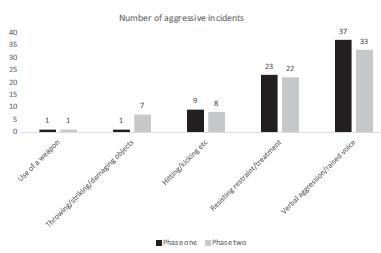
The Australian Council on Healthcare Standards 23rd Annual ACHS Quality Improvement Awards 2020
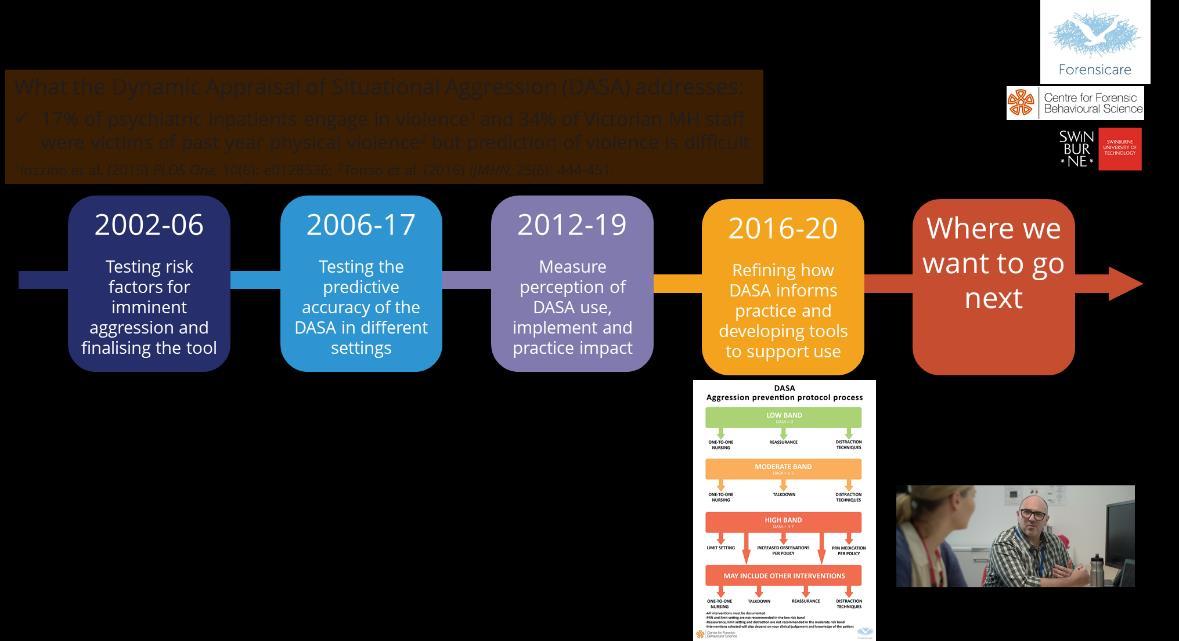
The 23rd Annual ACHS QI Awards 2020 Page | 10
APPENDIX
Figure 3. Trial 2 study design overview.
Figure 4. Effect of the eDASA+APP on aggression in the units during the experimental phase (Adjusted Odds Ratios). Note. Mean odds ratios (95% Confidence Interval) of changes during eDASA+APP relative to baseline by type of aggression adjusted for age of the consumer.


The Australian Council on Healthcare Standards 23rd Annual ACHS Quality Improvement Awards 2020
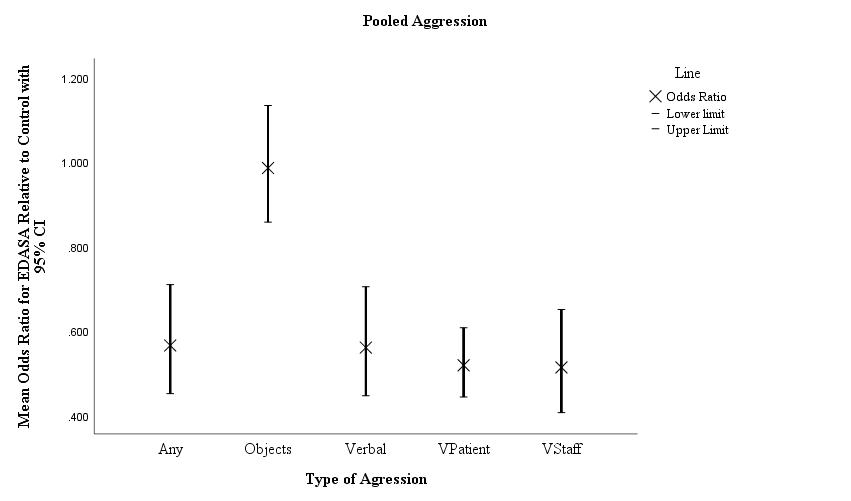
The 23rd Annual ACHS QI Awards 2020 Page | 11
Figure 5. Effect on use of nursing interventions (Adjusted Odds Ratios). Note. 1To1 = One to one nursing, Distract = Distraction Techniques, Limits = limit setting, PRN = medication to manage behavior, Reassure = Reassurance provided, Talkdown = verbal de escalation techniques used. OR = Odds Ration, CI = Confidence interval.
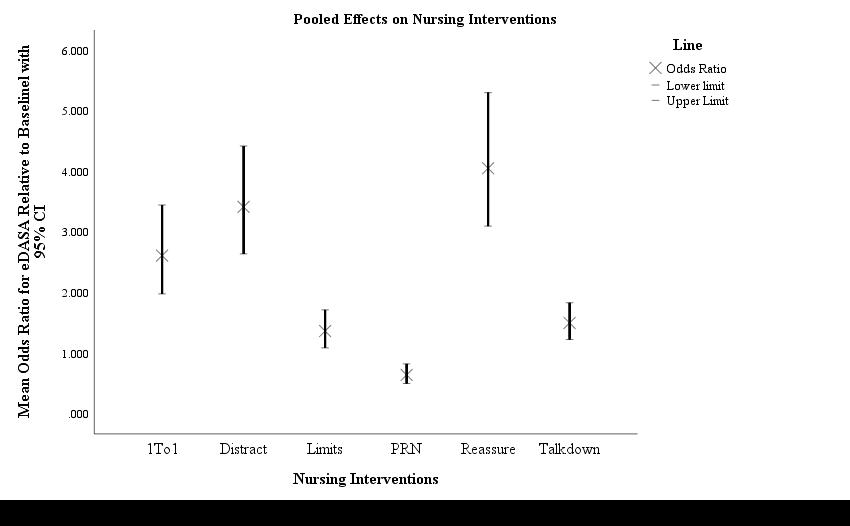

Appendix 3: Innovation in Practice and Process and Applicability to Other Settings
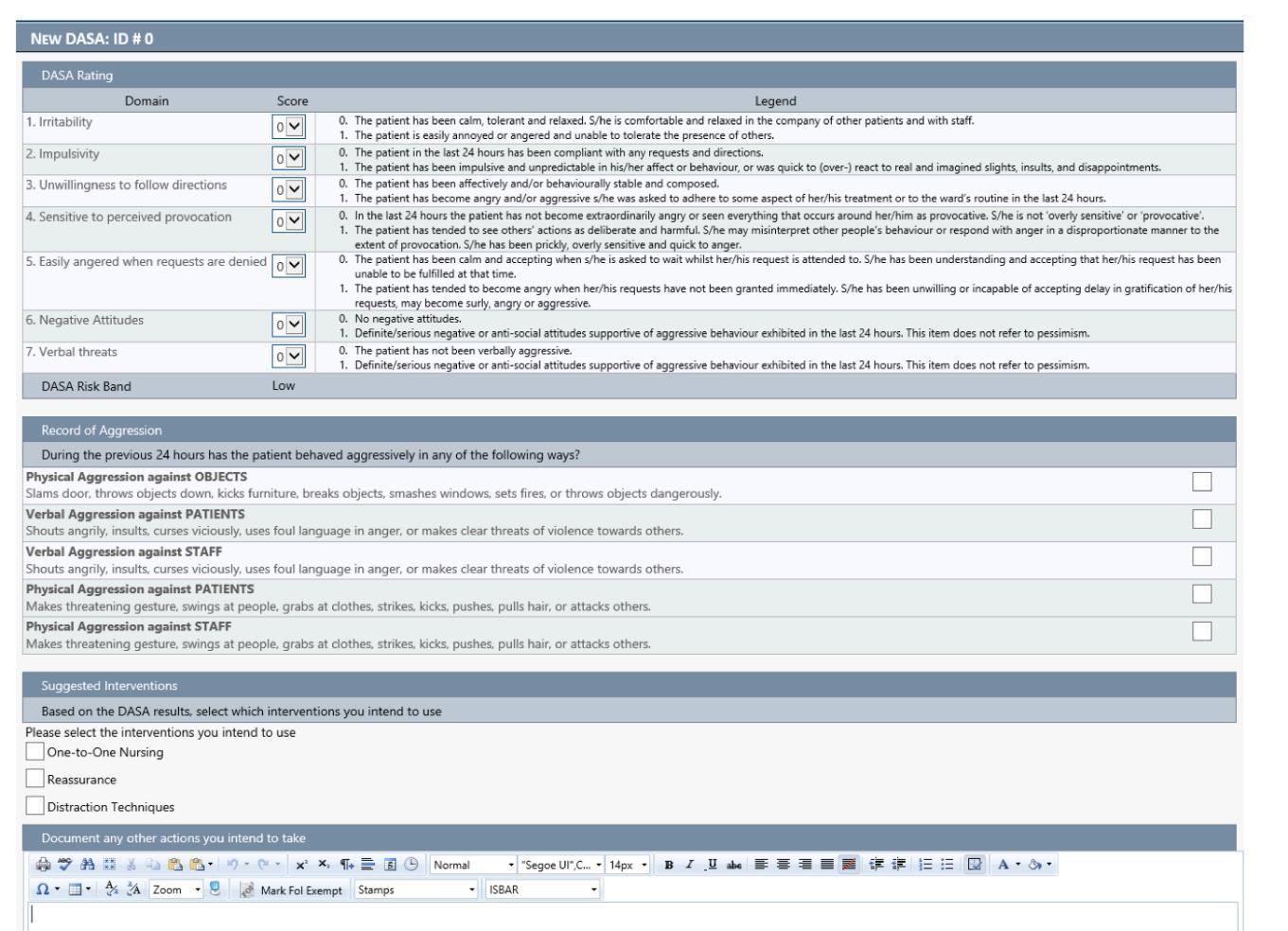
Figure 1. Form used to score and record daily DASA scores, aggression and proposed staff interventions.
The Australian Council on Healthcare Standards 23rd Annual ACHS Quality Improvement Awards 2020
The 23rd Annual ACHS QI Awards 2020 Page | 12
Figure 2. Aggression Prevention Protocol (APP). Practice and responding is additionally informed by provision of a published DASA+APP Nursing Practice Manual. A training video to educate staff on how to rate and formulate a preventative response on the basis of DASA scores has also been filmed to further strengthen staff expertise & practice.
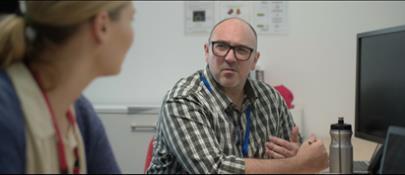
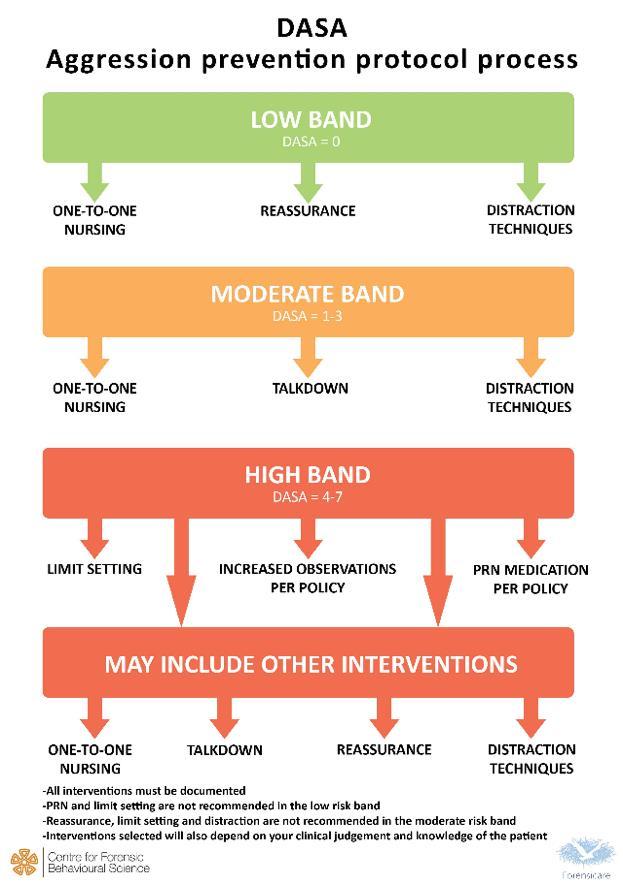 THEDYNAMICAPPRAISALOFSITUATIONAL AGGRESSION AGGRESSIONPREVENTIONPROTOCOL NURSINGPRACTICEMANUAL
THEDYNAMICAPPRAISALOFSITUATIONAL AGGRESSION AGGRESSIONPREVENTIONPROTOCOL NURSINGPRACTICEMANUAL
Figure 3. Forensicare is currently pursuing the creation of a data visualisation portal that will enable daily, weekly and monthly monitoring of DASA alongside aggression incidents to strengthen review of change in behavioural risk and acuity and better inform unit level allocation of resourcing and prevention intervention.



The Australian Council on Healthcare Standards 23rd Annual ACHS Quality Improvement Awards 2020
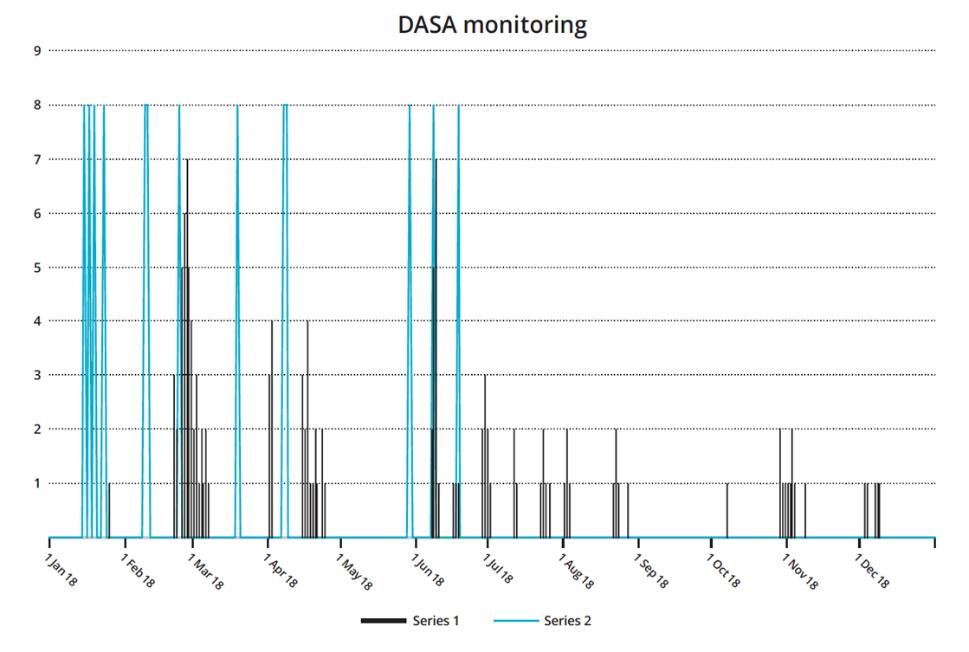
The 23rd Annual ACHS QI Awards 2020 Page | 13
Figure 4. Illustrating uptake in other mental healthcare settings, an electronic application of the eDASA in a clinical decision support tool utilised by a health service in the United Kingdom.


The 23rd Annual ACHS QI Awards 2020 Page | 14
The Australian Council on Healthcare Standards 23rd Annual ACHS Quality Improvement Awards 2020
CLINICAL EXCELLENCE AND PATIENT SAFETY
HIGHLY COMMENDED
North Metropolitan Health Service, WA
Mental Health, Public Health and Dental Services
North Metropolitan Health Service Smoke Free Mental Health Project
Heather Monteiro, Krista Coward, Joanna Fagan, Viki Pascu and Michael Sitas
AIM
The Smoke Free Mental Health Project (the Project) aimed to reduce smoking on mental health service sites to protect patients, staff and visitors from exposure to environmental tobacco smoke (ETS). A key objective was to improve clinical staff knowledge, skills and confidence to manage nicotine dependence among patients using evidenced based behavioural support interventions and pharmacological therapies such as Nicotine Replacement Therapy (NRT).
SUMMARY ABSTRACT

The Smoke Free Mental Health Project (the Project) was conducted in North Metropolitan Health Service (NMHS) Mental Health, Public Health and Dental Services (MHPHDS), at multiple sites including Graylands Hospital.
Cigarette smoking is the leading preventable cause of death in Australia. People with mental illness have rates of smoking 2 3 times higher than that of the general population and are more likely to experience ill health and death as a result of smoking related illnesses (NMHS MHPHDS Mental Health, 2019). Cigarette smoking and nicotine withdrawal can also impact on symptoms of mental illness and effectiveness of mental health and medical treatment. Despite this, an Australian study of public psychiatric inpatient units found that over one third of inpatients started smoking during their admission, with cigarettes often provided to patients by staff (BPACNZ., 2014 ). There is also evidence that both patients and nursing staff have begun smoking as a result of exposure to the smoking culture in mental health settings (Lawn and Campion, 2013)
Smoking on health sites exposes patients and staff to environmental toxins, is a proven health risk and an occupational health and safety issue for staff, patients and the community. The Smoke Free WA Health System Policy, a mandatory policy creating smoke free health services, includes a partial exemption for involuntary inpatients at Mental Health Units (MHUs) in WA, enabling involuntary inpatients to smoke tobacco during their admission. Due to the difficulties in
The Australian Council on Healthcare Standards 23rd Annual ACHS Quality Improvement Awards 2020
operationalising the exemption, invariably voluntary patients have also smoked on site.
While people with mental illness who smoke have higher levels of nicotine dependence, they are just as likely to want to address their smoking behaviours and just as likely to alter their tobacco use with appropriate support as the general population. However, people with mental illness are less likely to be offered assistance with their nicotine dependence.
Behavioural and pharmacological interventions are effective in helping patients abstain from smoking, making them a vital component of smoke free health services. They can also help to maintain improvements in smoking behaviour in the long term after discharge from MHUs. Not engaging in smoking cessation interventions acts as a lost opportunity for significantly improving mental and physical health outcomes of patients.
To reduce the impact of smoking and mental health the NMHS MHPHDS Executive committed to creating a totally smoke free health service, thereby removing the exemption for involuntary mental health inpatients as of 27 August 2019. Governance systems were established, led by a Steering Group chaired by the Director Public Health. The Project aimed to support Mental Health staff and patients through this transition, adopting a supportive approach by improving clinical staff knowledge, skills and confidence to manage nicotine dependence among patients using evidenced based behavioural support interventions and pharmacological therapies such as Nicotine Replacement Therapy (NRT).
Key activities included:
1. The development of new Smoking Care Guidelines and tools to guide staff to systematically identify patients who smoke and provide support to address nicotine dependence using the ABCD (Alfred Health, 2015) approach: Asking; providing advice (Brief intervention); recording the action taken at the point of hospital discharge (Communication at Discharge).
• A new NRT Assessment tool was developed to support staff to ask patients about their smoking status and assess nicotine dependence and management on admission.
• The Guidelines support staff to provide advice about pharmacological therapies such as NRT to replace the nicotine from smoking and reduce the symptoms of nicotine withdrawal. Evidence suggests that NRT increases the success of quitting smoking by 50 70%.
The 23rd Annual ACHS QI Awards 2020 Page | 15
• The Guidelines also endorse the safe use of higher dose NRT patches in combination with a faster acting NRT to better manage nicotine withdrawals. Combining the nicotine patch with an oral form of NRT can increase quit rates by 34 54% compared to using the patch alone. Due to its proven efficacy, the nicotine mouth spray has also been added to the NRT options available to patients.
• Behavioural support interventions, or non pharmacologicalinterventions,cantakethe form of advice, encouragement, discussion or distraction activities. The Guidelines now provide evidence based non pharmacological interventions that can be offered on the ward. Carbon monoxide monitors have also been introduced to measure expired carbon monoxide levels which has shown to be useful to demonstrate the reduction in smoking to and verify progress.
2. Face to face Smoking Cessation Support training was developed and delivered to more the 460 clinical staff to support the implementation of the new Guidelines, which proved to be effective and helped to ensure a consistent approach in supporting patients who smoke across the health service. This training has now been adapted into an e Learning program and embedded into the staff induction program.
3. To avoid the risk of patients experiencing symptoms of nicotine withdrawal if unable to access NRT in a timely manner, a Nurse Initiated Nicotine Replacement Therapy Policy was introduced to enable the nurse in charge of the shift or the delegated registered nurse to initiate NRT. This had previously required a medical staff member to initiate NRT.
4. Throughout the course of the implementation of the Project, nine guest speakers presented best practice evidence on smoking and mental health to staff. This included seminars with representatives from Quit Victoria and Alfred Health (Victoria), supported by Cancer Council WA (CCWA).
5. The Smoke Free NMHS Intranet Hub developed as part of this Project proved to be an effective way to increase staff awareness about the Guidelines as well as information about smoking cessation training, resources and evidence.
• All NMHS staff are now informed of the Smoke Free WA Health System Policy at induction and are referred to the intranet hub for more information.
Key outcomes include:
1. The development of MHPHDS Smoking Care Guidelines for clinical staff, in combination with a
The Australian Council on Healthcare Standards 23rd Annual ACHS Quality Improvement Awards 2020
tailored face to face Smoking Cessation Support training package. Almost 70% of relevant staff at Graylands Hospital completed this training (n=282). Staff completing post training reported increases in confidence to manage smoking onsite (56%); knowledge to manage nicotine addiction among patients (73%); and likelihood to encourage patients cut down or quit smoking (76%).
2. Pharmacy records show increased uptake of NRT. At Graylands Hospital, the number of patients accessing NRT increased by 76%. Incidentally, some patients have now reconsidered their smoking behaviours and have subsequently reduced or quit smoking.
3. An extension of a program of distraction activities was established for patients and increased from five to seven days, which resulted in a five fold increase in Smoking Support Behavioural Interventions in wards with long stay patients.
4. Despite the perceived increased risk of patient aggression resulting from nicotine withdrawal pre intervention, hospital security data suggests a reduction in incidents of physical violence and aggression where smoking may have been a contributing factor.
5. Onsite evidence of smoking decreased at Graylands Hospital by 60%; and at Selby Lodge by 82%. Tobacco related products such as lighters, and waste have been removed from patient areas; the sale of cigarettes at the volunteer run Graylands Canteen has ceased; and new positive smoke free signs installed creating a safer environment for mental health patients, staff and visitors.
Conclusion

The Smoke Free Mental Health Project (the Project) aimed to support Mental Health staff and patients through its transition to become totally smoke free. As a result, new policies and practices ensure nicotine dependent mental health inpatients are given the support they need to reduce and cease smoking whilst in the care of NMHS.
NMHS is now a role model for other mental health services in WA, and advocates for the introduction of evidenced based, multi strategic approaches to care for mental health patients who smoke.
The 23rd Annual ACHS QI Awards 2020 Page | 16
AIM
Sydney Local Health District, NSW RPA Virtual Hospital
rpavirtual a new
caring
rpavirtualisanew modelof carewhich combinesSLHD’s integrated hospital and community care with the latest digital solutions. rpavirtual acts as a bridge between hospital specialist services and patient care in the community. A purpose built 24/7 Virtual Care Centre was established on the Royal Prince Alfred Hospital campus and equipped with ‘Care Pods’ that include videoconferencing technology and the ability to remotely monitor patients with wearables. See Appendix 1 for photos of rpavirtual.
The aim was to introduce a new virtual hospital model and to implement a clinical safe virtual model of care for COVID 19 patients in home isolation or health hotel quarantine.
SUMMARY ABSTRACT

An analysis of population projections and service demand was a key driver in considering new, integrated and sustainable models of outpatient and community care in Sydney Local Health District (SLHD). By 2036, the SLHD population of 700,000 is projected to increase by 43%. Combined with increasing rates of chronic disease and a rapidly ageing population, an 84% increase in emergency department presentations is also predicted by 2026.
Virtual models of care have been can reduce demand on ‘bricks and mortar’ hospital inpatient care and outpatient clinics and increase patient and carer satisfaction by supporting patients to remain in their own home rather than in hospital.
Whilst there were examples of long established virtual care services in NSW, these were largely hospital in reach models rather than direct virtual care delivery to patients. Consultation to inform the introduction of a virtual hospital in SLHD was extensive and focussed on designing the physical infrastructure, digital solutions and initial clinical models of care.
The RPA Virtual Hospital, known as rpavirtual, was launched in February 2020 as an alternative, sustainable solution to increasing demand for healthcare in Sydney.
A variety of patient cohorts have been enrolled for care including palliative, community mental health, cystic fibrosis and other chronic conditions. On March 5 2020, rpavirtual began a rapid redesign to prepare to deliver virtual health care to stable patients with COVID 19 in the community using remote monitoring. On 11 March, rpavirtual commenced remote monitoring of COVID 19 positive patients and later commenced care to COVID 19 negative patients in health hotel quarantine.
Over 3,500 unique patients have been cared for in the first seven months of operation, with high reported patient satisfaction. Evaluation results to date confirm that hospital type care can be delivered safely in the community with the right technology and governance. To date, 365 patients have provided feedback on their experience of care with 86.8% rating their care as good or very good and 91.4% feeling confident knowing their condition is monitored virtually. See Appendix 2 and 3 for patient experience data.
Within a short period, rpavirtual has positioned itself as a leader in the Australian virtual healthcare space, informing state wide strategy for virtual care and has been critical to the New South Wales’ response to the COVID 19 pandemic.
The 23rd Annual ACHS QI Awards 2020 Page | 17
The Australian Council on Healthcare Standards 23rd Annual ACHS Quality Improvement Awards 2020
way of
Freya Raffan, Miranda Shaw, Dianna Jagers, Owen Hutchings and Cassandra Dearing
WA Country Health Service, WA Geraldton Hospital
AIM
The SAFER Tool was designed to provide a practical pictorial educational tool to consumers and staff on the Falls Risk and Management Plan (FRAMP) Minimum Interventions. The SAFER Tool was designed in collaboration with consumers and staff to facilitate key education messages on falls prevention, pressure management and cognitive impairment to minimize risk during hospital admission.
SUMMARY ABSTRACT

The NSQHS Standard 5 Comprehensive Care, aims to ensure that risks of harm for patients during
health care are prevented and managed through targeted strategies. It includes actions related to falls, pressure injuries, nutrition, mental health, cognitive impairment and end of life care. WA Country Health Service (WACHS) acknowledges that completion of a falls risk assessment is the first step in preventing falls. The MR521 Falls Risk Assessment and Management Plan (FRAMP) contains minimum interventions to be implemented for all general adult inpatients. As part of falls prevention and education it is required that these minimum interventions are put in place by staff and communicated to patients. The SAFER Tool Project focused on presenting these minimum interventions in a pictorial tool. SAFER is an acronym derived from the actions “Show, Aids, Facilitate, Educate and Remove”. The SAFER tool comprises an A3 poster positioned bedside of all general ward beds. It is utilised as an education tool for patients, carers, nursing, medical, allied health and support services staff to raise awareness to falls risk, cognitive impairment, management and prevention strategies.
The 23rd Annual ACHS QI Awards 2020 Page | 18
The Australian Council on Healthcare Standards 23rd Annual ACHS Quality Improvement Awards 2020
SAFER TOOL PROJECT Partnering with consumers to improve outcomes and minimise risk of falling and pressure injuries Narelle Dennett, Karen Zayco, Liza Doble, Kirra Pallant and Shannon Mcaullay
CLINICAL EXCELLENCE AND PATIENT SAFETY
TABLE OF SUBMISSIONS
Alfred Health
Clinical Governance Unit
Behind closed doors: Improving the safety and quality of patient care through the novel application of Telehealth within the acute inpatient setting
Lucy Martiniello, Billy Wickham, Mehmet Gurkan, Duane Miller, Courtney Royston, Gordon Bingham, Erica Tong, Nicole Rasmussen
Royal Perth Bentley Group Patient Support Services/SAFE Department (SAFE/BeSAFE Teams)

Improving Patient Safety Through utilising an Electronic Task Tracking Tool
Katherine Birkett, Diana Teow, Bill Poposki, Sean Sng, Tim Bowles
Bolton Clarke (RDNS Ltd) Care Innovation Team
Achieving clinical excellence for older Australians: the Bolton Clarke Service Delivery Framework and Models of Care for Community and Residential Aged Care settings
Janeen Cato, Kath Paine, Tracy Aylen, Leanne Davey, Kylie Elder, Kate McLeod, Fleur O’Keefe
Centenary Hospital for Women and Children
Reducing early births at the Centenary Hospital for Women and Children Fetal Medicine Unit
Roberto Orefice, Boon Lim, Julia Smythe
Canossa Hospital (Caritas)
Outpatient Department
Enhancing patient care in the Out patient Department of Canossa Hospital by an interactive “nursing function module” in the Hospital Information System
David Tai Wai Ho, Lucy Chik Pui Choy, Bryan Man Hay Chan, I Lee, Alan Young, Amy Chan Chui Yuk, Lung Suet Fan, Nursing Manager
Royal Adelaide Hospital Neurosurgery Department
Reducing Hospital Length of Stay for Brain Biopsy Patients from 3.9 days to 23 hours with the stretch goal of performing brain biopsy as a day procedure
Jai Kaur, Adam Wells
St John of God Midland Public and Private Hospitals Emergency Department ECG audit
Carolyn Chapman, George Petrov, Helen Daniels, Bhaumik Mevavala
Sydney Local Health District (SLHD) – Concord Hospital Psychology Mental Health
The effectiveness of crisis interventions, targeted psychological strategies and support during isolation and/or quarantine.
Lila Petar Vrklevski, Owen Hutchings, Cassandra Dearing, Miranda Shaw, Victor Storm, Sarah Whitney
Sydney LHD Concord Repatriation General Hospital Department of Intensive Care Services
The role of simulation in preparing the healthcare workforce for providing CPR during medical emergencies in the COVID 19 pandemic
Christopher Yu, Wesley Yao Lin Yang, Gabriella Charlton, Christine Ma, Seshika Dinali Ratwatte, Clarence Yeong, Asim Shah
Eastern Health Quality, Planning and Innovation
Imbedding Open Disclosure as part of normal obstetric care a multi modal approach
Julie Preston
Fairfield Hospital Paediatrics and Operating Theatres
Improving Surgical Management for Paediatric Patients
The Australian Council on Healthcare Standards 23rd Annual ACHS Quality Improvement Awards 2020
The 23rd Annual ACHS QI Awards 2020 Page | 19
Wayne Phillips, Liecer Daley
Gold Coast Health
GCHHS Intensive Care Services
Channel 101: Reducing the impact of DELIRIUM in Intensive Care
Kate Elliott, Jack Matulich
Gold Coast Hospital and Health Service
After Hours Care Unit, Centre for Health Innovation
In Hours Care to All Hours Care’ Gold Coast Hospital and Health Services transformation of After Hours Care
Hayley Frieslich, Crystle Dries, Melany Harper, Tracey Doherty, Rachael Smithson, Elisha Roche
John Hunter Hospital HNELHD
Maternity & Gynaecology services
Maternity Assessment Bay: Keeping Women Safe
Wendy Tsang, Angela Boulton, Andrew Woods, Cathy Richards, Jacqueline Allabyrne, Mandy Hunter Hornsby Ku-Ring-Gai Hospital
Aged Care and Rehabilitation Services

NSLHD Frailty Initiative
Susan Kurrle, Linda Xu, Catherine Richards, Katie Lee, Lisa Eldridge, Jordana Pancetta, Lara Pasternak, Annie Yu Hornsby Ku ring gai Hospital
Orthopaedic Fracture Clinic
No Bones About it
Katie Lee, Bronwyn Nolan, Deb Stewart, Matthew Smith, Sam Ah Kit, Jane Waldron, Clare Skinner, Anna Abeska Icon Cancer Centre Australia
Quality
Redesign and implementation of new patient health history and patient assessment medical records in an integrated cancer care setting
Kyla Snelling, Joanne O’Shea, Renee McMullen, Justine Morrow, Amanda Waldon, Clare Smith Icon Cancer Centre
Quality Team and Icon Nurse Education Team (INET)
Development and implementation of a revised troubleshooting guide for the access and management of Central Venous Access Devices (CVADs) in day oncology
Cheree Morgan, Justine Morrow, Joanne O’Shea, Kyla Snelling, Katrina Sankey, Anne Fitzgerald, Amanda Connolly, Renee McMullen
International Medical Centre
Surgery/Infection Control/ Quality Improvement and Patient Safety
Reduce postoperative CAUTI occurrences for surgical cases
Dalia Alsaadi, Taher Yunus, Nashaat Hamza, Reem Alshaikh, Edelmira Q. Cabagan, Najla'a I. Baraja, Yasser Ramadan and Feras Haddad
Illawarra Shoalhaven Local Health District (ISLHD)
Emergency Services
“I can breathe” Implementation of a chest injury care bundle to prevent adverse events.
Kate Curtis, Michael Watts, Sharyn Balzer, Soni Putnis, Martin Jones, Nick Maytom, Anne Smith, Sarah Kourouche
Illawarra Shoalhaven Local Health District
Emergency Department Shoalhaven District Memorial Hospital
Time is Brain
Donna Jay, Rik Wheatley, Lhyriel Smith, Emma Griffiths, Bradley Scotcher
Illawarra Shoalhaven Local Health District
Midwifery Unit, Wollongong Hospital
Tears Will Fall
Fiona Reid, Helen Donovan, Cindy Anne Johnston
Karitane
Karitane Integrated Care
Oran Park An Exemplar Integrated Care Hub for the First 2000 Days
Grainne O’Loughlin, Justin Duggan, Melanie Hughes, Steven Weultjes, Martha Vasquez, Angela Wood, Penny Jones
Hong Kong Baptist Hospital
Nursing Administration Office
Multidisciplinary Fall Prevention Strategies to Reduce Falls in hospital
The Australian Council on Healthcare Standards 23rd Annual ACHS Quality Improvement Awards 2020
The 23rd Annual ACHS QI Awards 2020 Page | 20
Li Yuen Man Hilda, To Ka Wing, Cheung Ching Yee Cindy, Cheung Kim Keung Dennis, Yuen Wing Sze Jammie, Wong Oi
Lan Ellen, Lee Wai Yee Susanna
North Metropolitan Health Service Mental Health Public Health & Dental Services
Special Needs Dental Clinic
“Maggie Goes To The Dentist”
Tamarai Selvam, Christina Lin, Martin Glick, Magda Guzman, Rae Ann Mumford, Sarah Cooper
St John of God Midland Public and Private Hospitals
Quality and Risk
Hook, Line and Sinker a fishbone in action
Tracey Piani, Jo Jones
Metro North HHS
Metro North Mental Health
The journey of developing a Mental Health Consumer and Carer Partnership Co Designed Framework
Shelley Kulperger, Lisa Jones, Shirley Anastasi
Metro North Hospital and Health Service
Metro North Mental Health/ Adis 24/7 Alcohol and Drug Support
Adis Link: Assertive referral model for streamlined alcohol and other drug treatment

Hollie Wilson, Kim Sander, Jenny Mitchell, Anthony Bligh
National Critical Care and Trauma Response Centre
Department of Health
NCCTRC AUSMAT HOPES Helping Others Prepare for Emergency Situations
SODE Supporting Others During Emergencies
TOTES Teaching Others Through Emergency Situations
Jan Gibbett, Jason Gates
North Metropolitan Health Service MHPHDS Mental Health
Joondalup Community Mental Health Clinic
The Clozapine Journey
Carey Taylor, Alex Dare, Fiona Laird, Mechaiel Farag
North Metropolitan Health Service
Mental Health, Public Health and Dental Services Public Health
North Metropolitan Health Service Smoke Free Mental Health Project
Heather Monteiro, Krista Coward, Joanna Fagan, Viki Pascu, Michael Sitas
Northern Health Risk Management
Addressing Hospital Acquired Complications by harnessing local clinicians and multidisciplinary expert groups with data and analysis that is standardised from ward to board
Matthew Soo, Bill Shearer, Christine Polmear
Northern Health
Emergency Department / Project Management Office & HRO Transformation
Improving quality and safety of patient care through in situ simulation
Nancy Sadka, Tracey Martin
Melbourne Health
NorthWestern Mental Health Mid West Area Mental Health Service Community Team Outer The Health Improvement Clinic (HIC), a multidisciplinary physical health service incorporating the Mid West Area Mental Health Service Outer Community Team and Djerriwarrh Health Service
Alexis May
Odyssey House NSW
Corporate Executive
A big response to a bigger threat by the little cousins of healthcare: Alcohol and Other Drug Services fast tracking innovation of services to continue supporting vulnerable people
Chloe Tadorian, Julie Babineau, Karen Becker
Royal Brisbane and Women’s Hospital
Metro North Hospital and Health Service
Whole of hospital transformation: Implementing Q ADDS in the RBWH
Julian de Looze, Kristina O’Dwyer, Juliette Mewton, Shaune Gifford, Shane Townsend, Claire Muller, Meaghan
Osbourne, Mia McLanders
The Australian Council on Healthcare Standards 23rd Annual ACHS Quality Improvement Awards 2020
The 23rd Annual ACHS QI Awards 2020 Page | 21
Peninsula Health
Emergency, Anaesthetics, Paediatrics, Dietetics, Food Services, Support Services, Safer Care Unit
Improving anaphylaxis recognition and treatment
Shyaman Menon, Rob Jewson, Helen Kolawole, Alex Mclean, Gav Chaves, Karen Edis, Sue Sinn
Metro North Hospital and Health Service
Clinical Governance, Safety, Quality & Risk Office, Metro North HHS
A multi intervention approach to minimising preventable iron staining
Martin Canning, Ian Coombes, James Collins, Katherine Losinski, Ann Whitaker, Nicola Harper, Mark Butterworth, Noelle Cridland
Princess Alexandra Hospital Emergency Department
Response to Occupational Violence Emergencies (ROVE): The clinical, collaborative approach to Occupational Violence management in the healthcare setting
Karen Taurima, Sue Galbraith, Carl Shannon, Scott Nichol, Ben Horan, Ben Learmont, Duncan Brown, Krimesh Shukla Redcliffe Hospital, Queensland Health
Pharmacy Department
Theatre MedicineWISE Project: The Introduction of the Perioperative Pharmacist
Nicholai De La Cruz, Geoffrey Grima
Northern Sydney Local Health District
Neonatal Intensive Care Unit, Royal North Shore Hospital (RNSH)
Keeping Sweethearts Together
Karen Lawrence, Carla Saunders, Mary Paradisis, Alexis Fox, Eveline Staub, Nicholas Williams
Northern Sydney Local Health District
NSLHD Carer Support Service

NSLHD Carers @ the Bedside program
Philippa Bernauer, Barbara Lewis
Royal Brisbane and Women’s Hospital (RBWH)
Emergency and Trauma Centre, Critical Care and Clinical Support Services
Clinical Audit of Shoulder Dislocations presenting to RBWH Emergency and Trauma Centre
Jordan Young, Gary Mitchell, Janelle Heine
Royal Brisbane and Women’s Hospital
Medical Services and Department of Internal Medicine and Aged Care
UP LATE Improving After Hours Care
Julian de Looze
Royal Brisbane and Women’s Hospital
RBWH Accelerated Discharge & Rapid Re entry Plastic Surgery Pathway
Sandra Gosley, Carmen Mauchline, Kate Dickson, Tia Kemp, Joanne James, Vidhi Sharma, Lynda Potter, Matthew Peters
Royal Brisbane and Women’s Hospital
Department of Anaesthesia & Perioperative Services
Minimising hypothermia after surgery
Geoffrey Messer, Gunjan Chawla, Charles Cheung, Nathan Peters, Kerstin Wyssusek
Royal Perth Hospital, East Metropolitan Health Service
Pharmacy Department
CHOPA Clinical HandOver for Pharmacists Application. Improving clinical handover, communication and documentation among pharmacists
Scott Ripley
East Metropolitan Health Service
Royal Perth Bentley Group
East Metropolitan Health Service NDIS Access Project: A pilot project to enhance successful access to the National Disability Insurance Scheme for Western Australians with psycho social disability
Helen Ayres, John Buchanan, Alex Cann, Andrew Buzzacott
Royal Perth Bentley Group (RPBG)
Your Time Counts Program
RPBG Daily Stand Up Initiative
Donna Coutts Smith, Anhnie Nguyen
Royal Perth Bentley Group
The Australian Council on Healthcare Standards 23rd Annual ACHS Quality Improvement Awards 2020
The 23rd Annual ACHS QI Awards 2020 Page | 22
Occupational Therapy
Review of Pressure Cushion Provision to at risk populations within the Royal Perth Hospital Acute Care Setting
Sonja De Munck, Helen Jolly, Rebecca Hewton
Royal Perth Bentley Group
Hospital Logistics and Acute Access (Outpatients), Clinical Safety and Quality Unit, Department of General Surgery
Redesigning clinical care delivery by implementing a nurse led Surgical Outpatient Telephone Assessment (SOTAC) Outpatient model of care
Rosalia Drimatis, Asadah Sidon, Kim Hill, Sean Sng, T. Girschik, Sudhakar Rao, D. Weber
Royal Perth Hospital
Intensive Care Unit
Reduction of pressure injuries from a year to year view within a tertiary Intensive Care Unit specialising in trauma
Naomi Louise Hallsworth, Sarah Elizabeth Helen Shaw, Lorraine Wilson
State Major Trauma Unit, Royal Perth Bentley Group
Occupational Therapy
Assessing Post Traumatic Amnesia in Patients Following Concussion: A comparison of the Abbreviated and Revised Westmead Post Traumatic Amnesia Scales
Talia Pagel, Fiona Khamhing, Lauren Kerr
Sydney Local Health District
RPA Virtual Hospital
rpavirtual a new way of caring
Freya Raffan, Miranda Shaw, Dianna Jagers, Owen Hutchings, Cassandra Dearing
SA Health
Adelaide Dental Hospital SA Dental Service, Central Adelaide Local Health Network
Digital and telehealth triage and consultation for emergency oral and maxillofacial surgery cases under COVID 19 service restrictions
Michael Bradley SA Health
Health Promotion Unit, SA Dental Service Central Adelaide Local Health Network
Creating an Autism Friendly Dental Setting
Jane Heron Kirkmoe, Sue Stevens
Northern Adelaide Local Health Network (NALHN)
Division of Surgical Specialities and Anaesthetics (Nursing) Lyell McEwin Perioperative Unit
NALHN Lyell McEwin Hospital Perioperative Unit ACORN Audit Champions
Lisa Jones, Richard Clapham, Karen Mahoney, Allison Skewes, Sue Hammerling, Tina Sayce, Julie Alves
Central Adelaide Local Health Network, State wide Clinical Support Services, SA Pathology

SA Health
COVID 19 Drive Through Swab Collection Services
Genevieve Sturman, Sarah Taylor
Sir Charles Gairdner Hospital
Innovation and Improvement Unit
Opioid Wisely: Improving analgesia prescribing on discharge
Jill Kemp, Bojan Bozic, Zach Nizich, Matt Anstey, Megan Hart, Jemma Humann
Sir Charles Gairdner Hospital
Emergency Department
Why am I waiting Your ED Journey
Megan Rayner, Dick Beilby, Anita Denning
St John of God, Hawkesbury District Health Service
Perioperative Services
The Quiet Project
Sharon Fitzgerald, Candice Mussing
Balmain Hospital
Speech Pathology and Social Work departments
Feeling Sad? Ask 10 Q’s Collaborative Mood Screening in a Rehabilitation Setting
Pip Taylor, Gemma White, Bianca Block, Tim Hough, Anabelle Lynch
Sydney Dental Hospital and Oral Health Services, NSW Health
Department of Paediatric Dentistry
Smile Stronger, Smile Longer
The Australian Council on Healthcare Standards 23rd Annual ACHS Quality Improvement Awards 2020
The 23rd Annual ACHS QI Awards 2020 Page | 23
Yvonne Chau
St Vincent’s Health Network

St Vincent’s Hospital
Digitalising a rural haematology service in the country town of Griffith, NSW Nada Hamad, Eleni Mayson
St Vincent’s Health Network Sydney Rehabilitation Unit, St Joseph’s Hospital
Zero Harm: Developing a ward culture of safety
Elizabeth Roberts
Victorian Institute of Forensic Mental Health (Forensicare)
Thomas Embling Hospital, Inpatient Services and the Centre for Forensic Behavioural Science
Implementing an electronic instrument and clinical decision support system to predict imminent aggression and structure intervention to reduce aggression and the use of restrictive interventions
Tessa Maguire, Jessica Griffiths, Michael Daffern, James Ogloff, Brian McKenna, Chris Guest and Jo Ryan
Townsville University Hospital
Intensive Care Unit
A review of Graduated Compression stockings and the incidence of heel pressure injury in an Adult ICU Amanda Krauklis
Townsville Hospital & Health Service
Townsville University Hospital
Improving management of chlorhexidine allergy
Jenny Walsh, Alexandra Ryan, Michael Corkeron, Michael Heytman, Tracey Jones
WACHS Kimberley
Allied Health Department/Kimberley Population Health Unit
Implementation of the General Movements Assessment in the Kimberley Region
Sarah Thomason, Allison Wark
WA Country Health Service
Geraldton Hospital
Safer Tool Project Partnering With Consumers To Improve Outcomes And Minimise Risk Of Falling And Pressure Injuries
Narelle Dennett, Karen Zayco, Liza Doble, Kirra Pallant, Shannon Mcaullay
Western Australia Country Health Service
Bunbury Maternity Unit
A Positive Update to Antenatal Education at Bunbury Maternity Unit
Katrina Jones, Kasey Biggar
WA Country Health Service
Pilbara Population Health
Bridging the Health Gap: An innovative approach to reorientating primary health services to address health equity and accessibility disparities in rural Australia
Chantelle Pears, Lauren van der Linden, Suzie Rayner, Pauline Glasson
WA Country Health South West South West Regional Aged Care
Implementation of the Abuse of the Older People policy in South West WA
Kylie Pettit, Richard Arnold
Hong Kong University ShenZhen Hospital
Department of Nursing, General Medicine ward
Multidisciplinary Team Approach to Reduce the Incident Rate of Fall in Medical Ward
Lan Ping Shi, Yan Zhi Yi, Jian Fen Cao, Pei Shan Li, Chun Hong Liu, Li Qiong Zhou, Shan Shan He, Qiu Li Chen
West Moreton Hospital & Health Service
Women, Children & Family Services Division, Child Health
Target Home Visiting (THV) Intake Clinician Triage
Vanessa A. Martin, Ann Maree Sandeman
West Moreton Health
Knowledge Framework Clinical Advisory Group
West Moreton Region Care at the End of Life Knowledge Framework
Rosslyn Holloway, Carol Hope, Helen Gregory, Emma Hart, Sharyn Stieler, Lanette Lewis, Sarah Jane Gough, Elizabeth Davis
The Australian Council on Healthcare Standards 23rd Annual ACHS Quality Improvement Awards 2020
The 23rd Annual ACHS QI Awards 2020 Page | 24
West Moreton Health
Ipswich Heart Failure Service Chronic Conditions Service
West Moreton Health virtual care model for medication titration of heart failure patients in the community setting
Alicia McClurg, Rebecca Tomlinson, Ben Shea
West Moreton Hospital Health Service
Chronic Conditions Service
Reducing wait lists and optimising clinic appointment slots: Dietetics service delivery model improvements
Michelle Lang, Rebecca Thompson, Penelope Rayner, Shelley Smith, Melanie McAndrew
West Moreton Health
Patient Safety and Quality Unit Medical Services Division
‘Linking patient rights, technology, care and recovery’ The use of technology to support patient rights in the acute mental health units at West Moreton Health
Mark O'Connell, Nicole Andersen, Joy Wyatt
Western NSW Local Health District
Allied Health and Innovation Directorate
Allied Health Virtualisation
Dianne Harvey, Richard Cheney
Westmead Hospital, Western Sydney Local Health District Surgery/ Colorectal
Improving Outcomes Via Enhanced Recovery After Surgery Protocol
Graham Ctectecko, James Wei Tatt Toh, Jack Cecire, Kerry Hitos, Nimalan Pathmanathan, Toufic El Khoury, Karen Shedden, Fiona Gavegan
Blacktown Hospital
Blacktown Hospital, Department of Endocrinology & Diabetes, Blacktown Metabolic & Weight Loss Program (BMWLP)
The Power of Partnerships Integrating the Get Healthy Service into standard care for adults attending a public specialist obesity service: A Pilot Study
Sarah Driscoll, Ramy Bishay, Gideon Meyerowitz Katz, Golo Ahlenstiel
Western Sydney Local Health District Department of Diabetes & Endocrinology
Short but Sweet: A New Model to Enhance Junior Medical Officer Education about Diabetes Anna Duke, Tien Ming Hng, Brett Gardiner
WSLHD Mental Health Services
Blacktown Clozapine clinic
Clozapine Consumer Safety during COVID 19 Pandemic Harpreet Kaur, Sangeetha Pillai, Selena Leung, Ramanathan Ganapathy, Anoop Sankaranarayanan
Westmead Hospital, Western Sydney Local Health District Department of Infection Prevention Control
PPE Predict a novel data driven approach to modelling PPE demand and consumption
Ramon Z. Shaban, Andrew Kam, Nicole Phillips, Shizar Nahidi, Cristina Sotomayor Castillo, Cecilia Li, Elizabeth White, Pedram Bidhendi
Auburn Hospital
Emergency Department Treatment after Triage
Romesh Singam, Jodie Burke, David Douglass, Khanh Nguyen, Kerf Tan, Felicity Day, Keti Ristevska, Naresh KC
Blacktown Hospital
Therapies and Clinical Support Team, Mental Health Services
HE+AT Healthy Eating using Art Therapy
Deepali Vasani, Lissette Endacott, Anna Piperides Lee, Anoop Sankarnarayanan
Blacktown Hospital
WSLHD Obsessive Compulsive and Related Disorders (OCRD) Consultation Service

Supporting teams to deliver better outcomes for people with Obsessive Compulsive and Related Disorders (OCRDs Vlasios Brakoulias, Vincent Fimmano, Jane Pineda
State Medical Assistance Pty Ltd
Implementation of a Bariatric Patient Transport Service William Alexander, Ben Cant, Rebecca Carroll
The Australian Council on Healthcare Standards 23rd Annual ACHS Quality Improvement Awards 2020
The 23rd Annual ACHS QI Awards 2020 Page | 25
NON-CLINICAL SERVICE DELIVERY WINNER
Redcliffe Hospital, QLD Pharmacy Department
Drive Through Pharmacy Collections Minimising hospital visits for vulnerable patients
AIM
In response to COVID 19 and physical distancing requirements, a drive through collection service for medications was created. This reduced the number of patients in the hospital building waiting and collecting from the front counter of pharmacy. Further, this initiative aimed to reduce the higher risk of infection for special patient groups that were immune compromised or medically vulnerable.
SUMMARY ABSTRACT

Description
Outpatient prescriptions and colonoscopy bowel preparation medications were supplied to patients as they waited in their vehicles. Patients drove to the designated parking area and called a dedicated telephone number to advise pharmacy of their arrival. The service was utilised by patients and their carers as well as other hospital and community based staff collecting medications for patients. It minimised staff waiting times and foot traffic in the hospital. Medicine counselling that was normally performed face to face at the pharmacy counter was instead conducted via telehealth or telephone.
Action
The transition required changes to established processes to ensure service levels were maintained. Medicine counselling was conducted via telehealth or telephone. A dedicated phone number was set up for patients to call on arrival. Approval was granted to have patients park in a dedicated area at the hospital entry. A new position was established for an Advanced Scope Pharmacy Assistant to prepare and organise of drive through bookings, and delivery of medications to vehicles. Patients with repeat prescriptions were actively encouraged to leave them on file in the department, and to call when a refill was required.
Evaluation
An online consumer satisfaction survey was used to evaluate the service. 90% of respondents were ‘extremely satisfied’ and 10% were ‘very satisfied’ with the overall experience. Other questions assessed whether patients felt they had received sufficient information about their medicines, waiting times with the service, and their wish for the service to continue. Responses to these questions were similarly positive. A review of patient waiting times also demonstrated a significantly decreased waiting time in the hospital, while avoiding the need for car parking. This eliminated issues with patient car parking as well as making more parking spaces available for others. 669 patients received deliveries between March and June, helping to reduce foot traffic into the hospital. Our pharmacists were able to plan their workflow to counsel patients between hospital discharges and inpatient supplies, enabling a more relaxed and comprehensive education provision.
Implications
The drive through service demonstrated that pharmacy services can be effectively delivered using technology applications such as telehealth and the telephone. Feedback was very positive from patients. Overall convenience and the time saving benefits were commonly reported comments. The service also demonstrated the facility’s patient focused approach. By proactively adjusting services to minimise foot traffic into the hospital environment, the potential exposure of these vulnerable patient cohorts to infectious diseases was reduced. These features have positive benefits with patient compliance improving as a result. To further streamline the service, the department is currently assessing suitability of an Advanced Scope Pharmacy Assistant providing counselling for colonoscopy bowel preparations. Results from the initial trial was used to demonstrate the ability to reinvigorate the service in August due to the re emergence of local COVID 19 cases.
The 23rd Annual ACHS QI Awards 2020 Page | 26
The Australian Council on Healthcare Standards 23rd Annual ACHS Quality Improvement Awards 2020
Michael Spargo, Ann Whitaker, Geoffrey Grima and Alysha Hoogendoorn
REPORT APPLICATION OF ACHS PRINCIPLES

1 Consumer Focus
Patients presenting to hospital pharmacies for outpatient prescriptions often require specialised medicines. These medicines are often not available from community pharmacies due to their high cost and the lower frequency of use. These medicines include immunosuppressants, specialised antibiotics and antivirals for chronic infection control. They are used to treat conditions such as Cystic Fibrosis, HIV infection and for patients who need post transplant management. This group of patients are at higher risk of infection and have a greater consequence if they have an infection. Further, these patients already spend a disproportionately large amount of time in healthcare facilities. The drive through collection service reduced the number of visits and the total amount of time that these already time poor patients needed to be at the hospital to obtain their regular medicine supply. This improved patient safety and was appreciated by patients based on their feedback in the survey.
The hospital car park is located on the fringes of the hospital grounds, and is generally at capacity. To park and walk to the pharmacy department takes time and presents problems for some patients with mobility issues. The drive through medicine collection area was located right outside of the main entrance to the hospital. Patients also benefited by receiving medicines in the privacy of their own car, with minimal waiting time. An online consumer engagement survey was conducted from the start of the service, which provided timely feedback. The responses were used to adapt and improve the service. The results are presented below.
2 Effective Leadership
The drive through service was implemented quickly and involved a change to processes in the pharmacy and hospital. It required all staff to actively promote, engage and train others at short notice. The facility supported the change and have recognised the positive effect it has achieved. An Advanced Scope Pharmacy Assistant was trained to coordinate the bookings and collections. This training also expanded the scope of practice for an Advanced Pharmacy Assistant, with the intent to
include explanations of the preparations used for colonoscopies.
The drive through collection service was reinvigorated at a day’s notice late in August when the decision had been made to limit patient visitation to the hospital. This was in response to an increase in cases of Covid 19 in the nearby area. Through effective communication and refresher training, the number of drive through collections quickly reached the highs levels conducted previously.
3. Continuous Improvement
Once implemented, the drive through collection service was modified based on staff feedback and feedback from patients via the online survey. Some of the modifications made were to increase the flexibility of collection times with a focus on enabling collections by patients both before and after their work shifts. Patient payments were made in advance at the time of ordering, to reduce the need for patients to call back after the collection and effectively streamline an entire step of the process for patients and staff. Staff involved in counselling patients on new medicines began booking the collection on the same phone call to further improve efficiency. After undergoing training, the pharmacy assistant became able to assess patient’s understanding of the pre admission process for colonoscopies and was able to refer to the pharmacist for further education. We have begun the credentialing process for an advance scope pharmacy assistant to provide pre procedural medication counselling to patients.
4 Evidence of Outcomes
The drive through service initially operated from late March until the end of June. Over this time a total of 669 patients received a medicine delivery, contributing to a large reduction in patient numbers in the hospital foyer and waiting areas. An online consumer satisfaction survey was conducted during the operation of the service. A range of questions were asked to assess the overall satisfaction, the perceptions of how long the process took, an assessment of whether the patient received enough information about their medicines and whether patients felt they had the opportunity to ask any questions about their medicines. The results of the responses are below:
The 23rd Annual ACHS QI Awards 2020 Page | 27
The Australian Council on Healthcare Standards 23rd Annual ACHS Quality Improvement Awards 2020
The Australian Council on Healthcare Standards 23rd Annual ACHS Quality Improvement Awards 2020
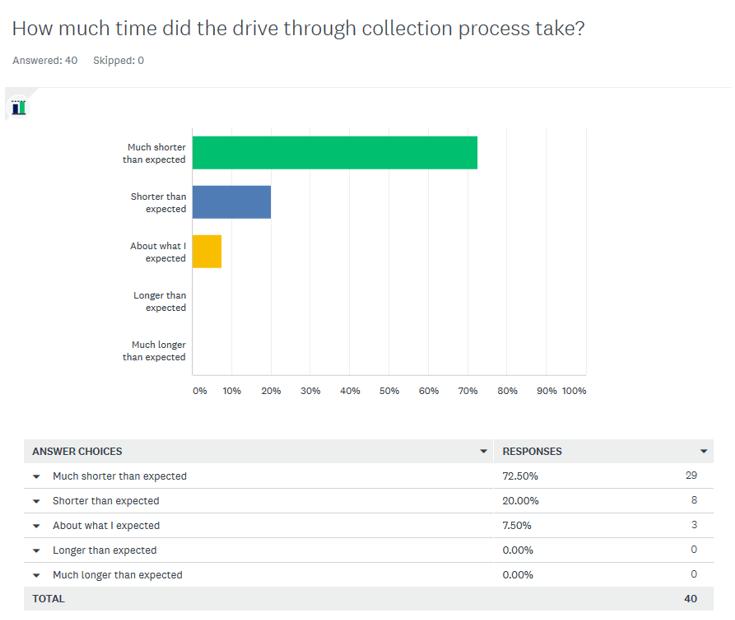
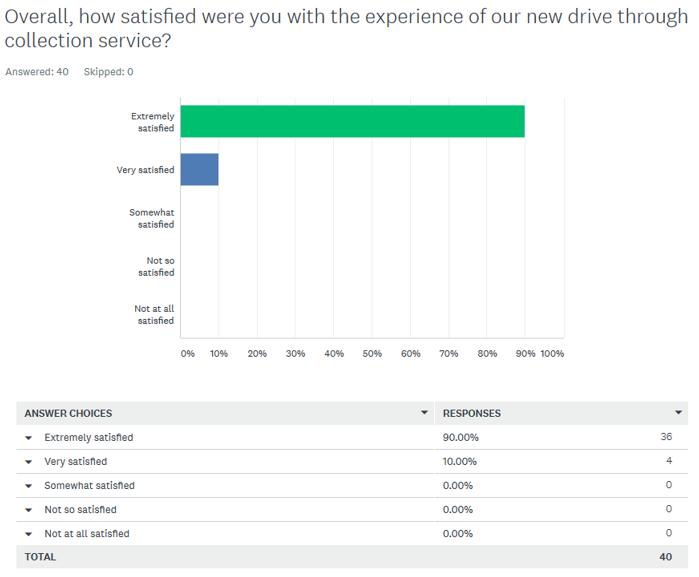

The 23rd Annual ACHS QI Awards 2020 Page | 28
An overwhelming majority of patients responded that they would like to see the service continue
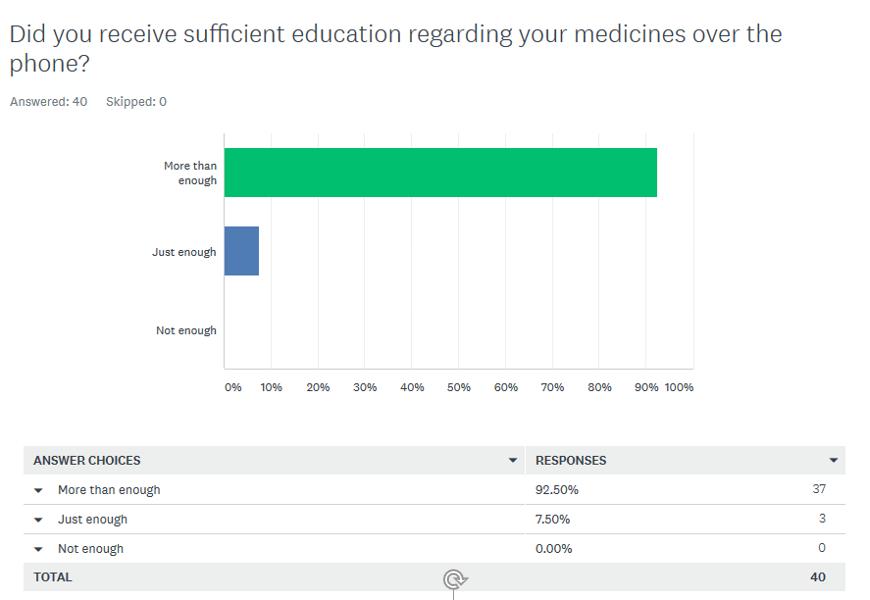

The Australian Council on Healthcare Standards 23rd Annual ACHS Quality Improvement Awards 2020

The 23rd Annual ACHS QI Awards 2020 Page | 29
The final question of the survey offered patients the opportunity to provide ideas to improve the drive through service or any other feedback. Some ideas included a signed and designated pharmacy car space, being able to order their medicines online and being able to pay for their medicines via BPAY or bank transfer.
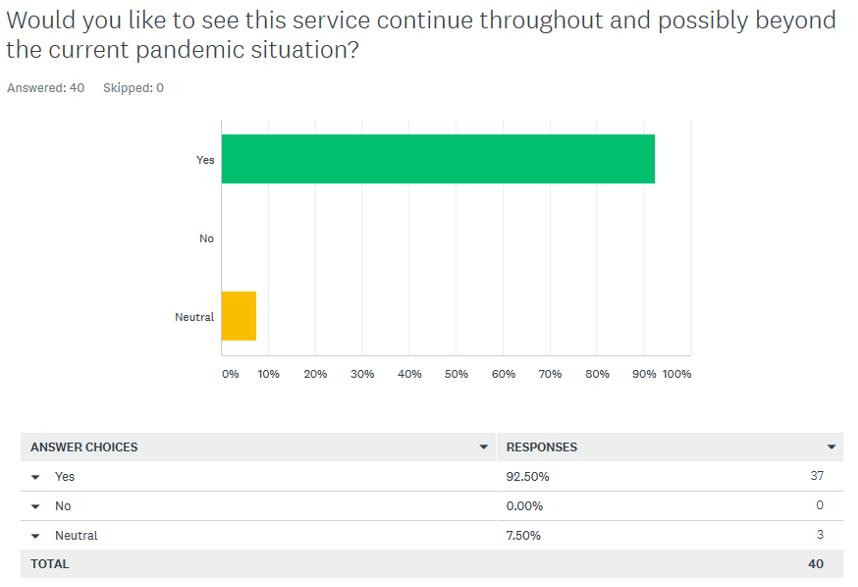
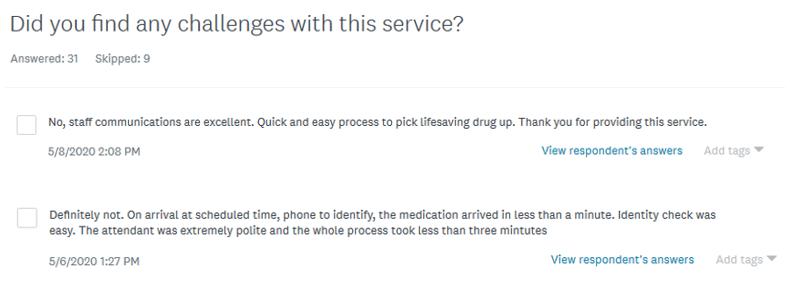
The Australian Council on Healthcare Standards 23rd Annual ACHS Quality Improvement Awards 2020

The 23rd Annual ACHS QI Awards 2020 Page | 30
The Australian Council on Healthcare Standards 23rd Annual ACHS Quality Improvement Awards 2020
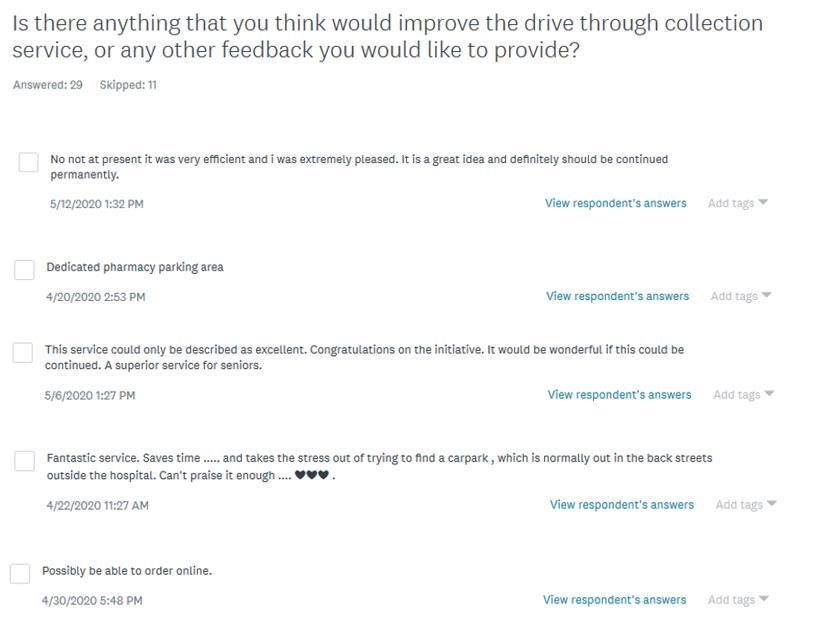

The 23rd Annual ACHS QI Awards 2020 Page | 31
5. Striving for Best Practice
The primary goal of reducing potential exposure to infection for our vulnerable patients was achieved. The short feedback loop from staff and patients allowed small modifications to the drive through service to improve its operation. This and the review of the survey responses was a key driver to its overall success. One of the benefits which was underappreciated initially was the ability to manage the workflow for the pharmacists counselling patients. This was important as the pharmacists were able to make phone calls and telehealth appointments at times that there weren’t high demands from hospital discharges or inpatient supply requests, improving patient flow and medication administration and safety related workflow in other areas. Outpatient prescriptions were able to be dispensed in a scheduled manner enabling workflow to be better managed.
INNOVATION IN PRACTICE AND PROCESS
The transition from face to face consultation to telehealth and telephone consultations was a new experience for our pharmacists and patients alike. The feedback demonstrated that it was effective and well received by patients. The benefits to our pharmacists in managing workflow improved efficiency and reduced pressure at times when patients were discharging. This improved patient flow in the hospital as medicines for discharge could be prepared with less interruptions.
The existing model of patients with outpatient prescriptions being seen in the hospital as a face to face interaction has
been challenged by the changes needed in response to COVID 19. The overwhelmingly positive feedback has shown that the service has potential to operate for the long term. The service will continue to be adapted and modified for improvement.
We have begun the credentialing process for an advance scope pharmacy assistant to provide pre procedural medication counselling to patients.
APPLICABILITY TO OTHER SETTINGS

The drive through collection service would provide a positive patient experience irrespective of the pandemic situation. The success in utilizing technologies like telehealth counselling have demonstrated that face to face delivery of services isn’t always necessary for routine activities. A drive through service would be applicable to other health services where ‘collection’ is required. This could be with home health equipment for occupational therapists or mobility support equipment from physiotherapists. The assessments could be made utilising a telehealth appointment and then the recommended aids or products could be collected via a drive through option.
The number of patients serviced via the drive through collection service highlighted the high volume of patients entering the hospital. Many of these visits could be reduced, benefiting everyone in the hospital by reducing congestion and infection transmission risk in general.
The 23rd Annual ACHS QI Awards 2020 Page | 32
The Australian Council on Healthcare Standards 23rd Annual ACHS Quality Improvement Awards 2020
NON-CLINICAL SERVICE DELIVERY
HIGHLY COMMENDED
Just Ask It!
AIM
Just Ask It aimed to increase the proportion of patients who identify as Aboriginal and Torres Strait Islander patients on presentation or admission at Auburn Hospital by 50% by February 2020. We aimed to improve the welcoming environment in accordance with version 2 of the National Safety and Quality Health Service Standards and build linkages with the local Aboriginal community in order to better identify Aboriginal and Torres Strait Islander patients, to provide culturally appropriate services and care.
SUMMARY ABSTRACT

Aim: Increase identification of Aboriginal and Torres Strait Islander patients on presentation or admission at Auburn Hospital to enable better provision of culturally appropriate services and care.
Issue: During the Organisation Wide Assessment against version 2 of the National Safety and Quality Healthcare Standards (hereby National Standards) in March 2019, it was identified that Auburn Hospital did not adequately address the needs of Aboriginal and Torres Strait Islander patients. A number of areas of deficiency were identified including a lack of strategic direction, inadequate identification of Aboriginal and Torres Strait Islander patients on presentation, an unwelcoming environment for Aboriginal and Torres Strait Islander patients and a lack of engagement with the wider Aboriginal community. Whilst the Cumberland local government area (LGA) only self identifies 0.6% of its population as Aboriginal and Torres Strait Islander (Census 2016), Auburn Hospital treats patients from the wider Local Health District boundaries, areas which have higher populations of Aboriginal and Torres Strait Islanders.
Only 0.86% of patients who presented to the Emergency Department (ED) (2017 18) identified as Aboriginal and Torres Strait Islander. A welcoming environment audit conducted in June 2019 returned a compliance rate of 23%, indicating the environment did not meet the requirements of the National Standards and staff were not adequately asking the question, as demonstrated by the staff survey.
Method: An Aboriginal and Torres Strait Islander Implementation Plan was developed, encompassing a range of strategies to improve identification of, and care provided to, Aboriginal and Torres Strait Islander patients.
The welcoming environment was reviewed with an audit conductedandchanges wereimplementedasaresult. Atour of the facility was conducted with Aboriginal Community Members who identified further areas for improvement. Changes included installation of flags and maps of Indigenous Australia, availability of the Welcome to Country video on all patient entertainment system screens, installation of additional Aboriginal art works and planning for a multicultural garden to link the Aboriginal communities with other Auburn communities.
A staff survery was conducted, identifying less than 80% of staff asked new patients if they identify as Aboriginal and Torres Strait Islander and this number reduced for patients who have previously been registered. There was a lack of understanding by staff of why they ask the question, with many responding they believe it is solely related to data requirements. An education program was developed for all administrative staff who register patients, designed and run by the Western Sydney Local Health District (WSLHD) Aboriginal Training Coordinator. Training was conducted in small groups in June 2019 and included discussions and brainstorming activities, allowing participants to explore themes or questions that were identified. An observational audit was implemented to monitor change in practice.
A 48 hour follow up program was initiated by an Aboriginal identifying Nursing Unit Manager. This program enables post discharge, culturally appropriate contact for Aboriginal and Torres Strait Islander patients to ensure their healthcare needs are continuing to be met in the community.
A formal referral pathway was implemented with the Aboriginal Maternal Infant Health Services to enable shared decision making with patients regarding antenatal care.
Results: Data indicates an upward trend in Aboriginal and Torres Strait Islander presentations to ED. There was a significant increase of 62% in the percentage of ED presentations identifying as Aboriginal and/or Torres Strait Islander from 2017 18 to 2019 20. There has been a substantial increase in referrals to the Aboriginal Liaison Officer, with an average of 2 referrals per month in 2019, increasing to an average of 9 referrals per month in 2020 (equating to four times the referrals). The Aboriginal Liaison Officer assists in ensuring patients access culturally appropriate services. There has also been improved linkages with the community through implementation of follow up
The 23rd Annual ACHS QI Awards 2020 Page | 33 The Australian Council on Healthcare Standards 23rd Annual ACHS Quality Improvement Awards 2020
Western Sydney Local Health District, NSW Auburn Hospital
Sally Henderson, Kristy Kendrigan, Riki Richards, Narelle Holden, Debbie Sharpe Lidiya Malinov and Tanja Nietlisbach
phone calls for chronic care patients, many of whom are within the Justice system, and the referral pathway with the Aboriginal Maternal Infant Health Services. These services have supported shared decision making with Aboriginal and Torres Strait Islander patients that considers culturally appropriate care and services and empowers patients to take control of their health.
There has been substantial improvement in staff asking the question for new presentations, with 100% of staff responding that they always ask the question for new patients. This has improved from 75% pre education. Observational audits of patient registrations showed an improvement from 60% compliance to 100% compliance with staff appropriately asking the questions.
Uniting War Memorial Hospital, NSW Allied Health and Integrated Care
Wellness checks at War Memorial Hospital connecting with our clients to prevent avoidable hospital admission and deterioration during COVID-19
Genevieve Maiden, Wendy Longley, Annabel Kingsford, Rachel Kingma, Julie Manger, Michael Fitzpatrick, Jill Hall and Lynda Elias
AIM
Despite clinical services remaining open for at risk clients during the COVID 19 pandemic, rehabilitation clinicians at the Uniting War Memorial Hospital (UWMH) became aware of clients deteriorating in the community due to social isolation, reduced or withdrawn formal and informal supports, and reduced access to their usual health support services including General Practitioner (GP) and specialist visits. In response to this emerging need, a multidisciplinary working group (i.e. “the project team”) at UWMH was rapidly formed to develop the “UWMH Wellness Check” care intervention. The goals of this intervention were to reduce the risk of deterioration and avoidable hospital admission for the vulnerable, elderly individuals under our care. We sought to achieve these goals by developing a new care intervention (the UWMH Wellness Check) by which staff could efficiently understand the clients’ current or emerging health and social support needs, and then effectively identify the best care and referral pathways required to alleviate any risks that were discovered.
SUMMARY ABSTRACT

As part of South Eastern Sydney Local Health District (SESLHD), Uniting WMH provides a comprehensive suite of rehabilitation services for older Australians living in the northern sector of the eastern suburbs of Sydney, with a
The welcoming environment has been re audited after the installation of maps of Indigenous Australia, Aboriginal and Torres Strait Islander flags, the Welcome to Country on the Patient Entertainment System and installation of additional Aboriginal artworks. Compliance increased from 27% at initial audit in June 2019 to 81% in April 2020.
Qualitative feedback from Aboriginal patients has been positive, with a patient interviewed for WSLHD’s The Pulse website in relation to the Welcome to Country video. This patient stated that it was good to feel welcomed to the hospital and that she would return to the hospital again.
vision of “You are never too old to live life”. The services have an anticipatory care approach to improving individuals' health status, preventing unnecessary hospitalisation, and preventing unnecessary injury or decline for people with acute, sub acute, progressive and/or chronic complex health conditions. The integrated set of multidisciplinary clinical teams have a culture of collaboration, as well as strong links with the local General Practitioners (GP’s), community groups and services providers (NSQHS actions 5.5 & 5.6). The hospital is known for health promotion programs and for strategies that improve the health literacy of consumers. As Waverley Local Government Area, in which the hospital is located, was a hotspot initially in COVID, the community was very mindful of isolating early. A key part of the described project was the responsiveness, with the project commencing immediately after the social isolation directions were given to the community. Additionally, the cultural fit with the way services are provided from this hospital as part of the broader community, made the consumer uptake of the process straightforward and well accepted.
Since March 2020, COVID 19 has posed unprecedented changes in our way of life. At UWMH we are in the business of reducing isolation and loneliness for older people, despite, ironically, isolation being a key factor in reducing the spread of COVID 19. For our clients, the newly mandated isolation measures meant that their ability to access formal and informal supports and health services was greatly reduced. So, initiating a more formal structure to ensure the wellbeing of our elderly clients during the pandemic was considered a priority for clinicians and managers. A proactive and targeted approach to contacting clients where face to face consultations were not possible or declined by clients, was considered an urgent need. This required an agile response by the team in order to meet the needs of our clients in a timely way.
The 23rd Annual ACHS QI Awards 2020 Page | 34 The Australian Council on Healthcare Standards 23rd Annual ACHS Quality Improvement Awards 2020
A group of key clinicians across the disciplines was rapidly brought together to form a “project team”, to address the identified new COVID 19 isolation related care needs of our clients (NSQHS action 5.5). A review of the literature (see key papers in the reference list) and consultation among subject experts in the team and consumers enabled understanding of the specific key issues that could lead to clients’ deterioration and hospitalisation, and which should thus be a focus of consideration by the project team.
The care intervention comprised 3 parts:

1) A letter was developed (including feedback from consumers around its content (NSQHS actions 2.8, 2.9 and 2.10)) and sent to clients to pre empt a phone call from our clinicians and to encourage clients to seek help for urgent needs from their GP, specialist or UWMH as required (Appendix One).
2) A Wellness Check questionnaire was developed, to guide consistency and efficiency with the clinicians’ phone calls to clients. The questionnaire was designed to prompt clinicians to ask about 12 specific areas of change in wellbeing that have been shown to predict heightened risk of health deterioration and hospital admission. It also included a decision making component to enable onward referral or follow up as required (Appendix Two).
3) The phone call wellness follow ups were conducted in August after the initial wellness check calls had been conducted, and captured qualitative information from clients around the benefits of the calls.
Clients targeted for receiving this new care intervention were initially those considered most at risk due to isolation, or expected loss of usual in home services. Due to the nature of UWMH’s client cohort, all clients were in the high risk aged group (>65yo) and most would be considered to have multi morbidities, increasing their vulnerability to COVID 19. Risk factors included living alone, those relying on regular community groups that had stopped running, those who relied on in home care that had been temporarily suspended, and those with family whose visits had ceased due to their vulnerability. Since initial implementation of the Wellness Check phone calls, clients who were receiving care at UWMH at the time of COVID 19
outbreak, discharged from services within the last six months, or on our wait lists were added to the list of clients to be contacted (excluding those in residential aged care facilities).
Furthermore, clients identified to be at extremely high risk were offered a series of Wellness Checks in the form of monitoring phone calls at regular intervals throughout the six month period. This included clients who were declining in home services due to COVID 19, and those with social isolation that couldn’t be addressed through other programs.
Over 1000 wellness checks calls were completed from the 16th March until 31st August by clinicians across a range of disciplines and services, reaching 474 vulnerable clients. By completing these Wellness Checks, the team were able to efficiently and successfully identify clients at risk of deterioration during this period of COVID 19 lock down. This early identification enabled onward referral and follow up to reduce the risk of crisis or hospitalisation.
Telehealth usage has been made more accessible and generally become a more accepted way of delivering care across NSW Health, with roll out and uptake being fast tracked with the COVID 19 pandemic. It is used when clinically appropriate to provide assessment, treatment or support via virtual means for patients and families while remaining at home. UWMH were able to utilise telephone and video conference modes to deliver these Wellness Checks, assess and appropriately triage and treat.
The Wellness Check project is an example of an innovation which aligns to the Premiers Priorities (NSW Government, 2020) of improving outpatients and community care, reducing preventable visits to hospital through caring for people in the community. By focusing on preventative healthcare in the community, the wellness checks help people stay as healthy as possible for as long as possible, while ensuring the hospital system operates efficiently and prioritises acute care resources for those who need it most.
The 23rd Annual ACHS QI Awards 2020 Page | 35 The Australian Council on Healthcare Standards 23rd Annual ACHS Quality Improvement Awards 2020
AIM
This Project was initiated by Royal Perth Bentley Group Mental Health Division in May 2019 to develop, build and strengthen relationships and pathways for mental health patients experiencing homelessness, and to increase knowledge and awareness across the community and government sector to create smoother pathways for this vulnerable cohort of clients .
Overall the aims of the project were to:

• Identify current RPBG MH inpatients and outpatients experiencing homelessness
• Build and strengthen pathways to stable accommodation
• Build collaborative partnerships with community organisations
• Provide staff training and education
SUMMARY ABSTRACT
Background
There is a well established body of literature that shows individuals experiencing homelessness have a higher prevalence of chronic disease, including mental illness, than those in the general population and the economic impact on the Western Australian (WA) health system is sobering.1 WA Health data from the 2014/15 financial year indicates that there were 31,654 inpatient days and 5,048 Emergency Department (ED) presentations for patients coded as homeless or No Fixed Address (NFA), with average length per separation three times higher than that of non homeless patients in the same year.2 This equates to a conservative cost of $79 million to the WA health system in that year alone.3 Conversely, some of the strongest evidence around reducing hospital demand has emerged for interventions targeted specifically to those who are homeless and have chronic Mental Health (MH) issues.4
The prevalence of MH issues within the homeless population is extraordinary. Within a 1,070 homeless patient cohort identified over a one year period at our hospital group, 91% had documented contact with state funded MH services. Data from the RPH Homeless Team’s first 2.5 years of operations showed that 12% of their 824 patient cohort (99 individuals)had a formal diagnosisof schizophrenia,over10x the world wide population prevalence of 1%.5 However, hospital presentations for MH among homeless people is
only the tip of the iceberg; undiagnosed and under or un treated mental illness in NFA individuals is common.
In spite of this, homeless patients in psychiatric inpatient and community mental health settings seldom have their most fundamental needs addressed, namely stable, suitable accommodation and appropriate levels of community support.6 Without these basics in place, good mental health cannot be achieved.
The Mental Health Homeless Pathway Project (MHHPP) in Perth is working to address this gap.
The MHHPP Model of Care
In May 2019, the MHHPP was established to improve service delivery by the MH services of the Royal Perth Bentley Hospital Group (RPBG) for patients experiencing homelessness. The RPBG MH service comprises 92 inpatient beds over three locations, two community outpatient clinics, a specialised aboriginal MH service and a small capacity MH outreach service for rough sleepers.
Prior to the establishment of MHHPP, it had been identified that 30% of inpatient (IP) MH beds in RPBG were occupied by individuals experiencing homelessness. Many repeatedly cycled in and out of the MH services. Others had long IP admissions (>28 days), occupying expensive IP beds because of a lack of any appropriate discharge options, largely related to housing.
The MHHPP is run by a Project Manager with a social work background and extensive experience in community homelessness services. She liaises with members of each of theRPBGMH servicestoidentifyandassisttheirMHpatients experiencing homelessness.
Key Elements of the MHHPP
•
•
•
• Provide staff training and education
The MHHPP is an active participant of the 50 Lives 50 Homes Housing First Program, which to date, has permanently housed over 240 rough sleepers.7 By being a partner of this program, MHHPP is able to refer individuals directly from the hospital to services that aim to rapidly house and provide wrap around support to some of the most vulnerable rough sleepers in Perth.
Hospital Use
In the one year period (from 9/5/2019 to 24/4/2020) that MHHPP has been operating for, a total of 1,070 individuals with No Fixed Address were identified within RPBG. Of these, 870 had documented MH service engagement and were considered ‘in scope’ for this project.
The 23rd Annual ACHS QI Awards 2020 Page | 36 The
23rd
Australian Council on Healthcare Standards
Annual ACHS Quality Improvement Awards 2020
Royal Perth Bentley Group – East Metropolitan Health Service, WA Social Work Department Mental Health Homeless Pathways Project (MHHPP) Kat Ahlers and Carla Francis
Identify current RPBG MH inpatients and outpatients experiencing homelessness
Build and strengthen pathways to stable accommodation
Build collaborative partnerships with community organisations
Hospital use has been calculated for the first 261 patients seen by MHHPP in RPBG hospitals during a two year period prior to the project. These 261 patients accumulated a total of 1,936 ED presentations and spent 14,119 days admitted as an inpatient in the year before the MHHPP. In WA, the average cost of an ED presentation is $838, and each day spent in a psychiatric inpatient bed costs $1,475.8,9 Based on these figures, for the 261 individuals they used approximately $22.5million of hospital healthcare usage in a two year period. If the averages for the 261 were consistent for the whole cohort of 870 in scope individuals, this could amount to approximately $75million in hospital use over two years.
Why MHHPP is Needed
The WA Office of the Auditor General (OAG) reviewed the use of state funded MH services (SFMHS) from 2013 2017. Within the 212,000 cohort of SFMHS users, just 10% of individuals used 90% of all state funded MH IP bed days. This 2019 report recommended rigorous review of this high use cohort to develop alternative “pathways that enable these people to spend as much time as possible in the community and then move through more intensive services as they need to”. 11
While the OAG report did not state the proportion of these individuals experiencing homelessness, we suspect that many homeless people are in this cohort. Within RPBG data, we have already identified that homeless individuals occupy 30% of RPBG MH inpatient beds at any one time.
If homelessness in MH patients was rapidly addressed via much cheaper social inputs such as housing and supports, rather than expensive hospital care, the result would be better patient outcomes and considerably lower cost to the public purse. This situation highlights the divide between generally well funded health services like hospitals, that are heavily impacted financially by social problems like homelessness, and the community homelessness sector which is chronically underfunded so can’t address the cheaper housing and support needs of the homeless population which would reduce their healthcare usage.
Conclusion

Contacts with the hospital can often be the portal through which the road to housing and recovery begins 12
The MHHPP is an example of a service that is actively identifying and engaging with RPBG’s homeless patients in their MH services. The MHHPP is attempting to link them with appropriate services upon discharge to access the accommodation and support they require. We’ve identified that better patient outcomes and allocation of public services could both be achieved in this high cost patient cohort by connecting MH services to rapid access to the fundamental basics of good MH and wellness, a stable and safe place to stay and appropriate supports to stay well.
The 23rd Annual ACHS QI Awards 2020 Page | 37 The Australian Council on Healthcare Standards 23rd Annual ACHS Quality Improvement Awards 2020
AIM
NON-CLINICAL SERVICE DELIVERY
TABLE OF SUBMISSIONS
Auburn Hospital
Just Ask It!
Kristy Kendrigan, Riki Richards, Narelle Holden, Sally Henderson, Debbie Sharpe, Lidiya Malinov, Tanja Nietlisbach Child and Adolescent Health Service (Special Commendation Award) Child and Adolescent Mental Health
CAHS Statewide Specialised Aboriginal Mental Health Service: Orienting towards an Aboriginal culturally secure service Anne Wilson, Phillippa Farrell, Dion Kickett, Roger Golling, Trish Sullivan
Canberra Health Service
ACT Trauma Service
Prevent Alcohol and Risk related Trauma in Youth (P.A.R.T.Y.) Program Online Initiative
Nardine Johnson, Beelah Bleakley, Rebekah Ogilvie
Echuca Regional Health Medical Day Treatment Unit
Campaspe Cancer Support Project Tracie Pearson
Royal Flying Doctor Service Tasmania
Primary Health Care Program
RFDS Mobile Health Hubs
Cecilia Mwangi, Zoe Page, Nicole Grose, Lisa Pretorius, John Kirwan Hornsby Ku ring gai Hospital
Executive Unit Operational Huddles
Kylie Leach, Linda Davidson, Blake Edwards, Bronwyn Nolan, Samuel Ah Kit, Deb Stewart Icon Cancer Centre
Icon Cancer Service

Embedding a Clinical Governance Framework into an integrated National Cancer Care provide Joanne O’Shea, Ann Maguire, Renee Mc Mullen, Amanda Waldon, Kyla Snelling, Justine Morrow International Medical Centre Pharmacy Department
Waiting Time of Out Patient Pharmacy Ali Saber, Basmah AlQumysh, Jamal Siddiqi, Reham Salem
Illawarra Shoalhaven Local Health District Nursing and Midwifery Directorate
Your Attitude Matters: Building a Safety Culture
Valerie Wilson, Denise Edgar, Sarah Kalchbauer, Maree Parker, Jackie Donsante, Sharon Morgan, Bekk Middleton, Christopher Hinder
Redcliffe Hospital Pharmacy Department
Drive Through Pharmacy Collections Minimising hospital visits for vulnerable patients
Michael Spargo, Ann Whitaker, Geoffrey Grima
Royal Bahrain Hospital
Infection Control and Quality
COVID 19 Prevention and control Strategies
Anal Thankappan, Tariq Almusawi, Rehana Nazir
Royal Perth Bentley Group – East Metropolitan Health Service
Social Work
Mental Health Homeless Pathways Project (MHHPP)
Kat Ahlers, Carla Francis
Southern Adelaide Local Health Network
Partnering With Consumers Advisory Group
SALHN’s Consumer Engagement Journey
Peter King, Fran Gallardo
The 23rd Annual ACHS QI Awards 2020 Page | 38
23rd
The Australian Council on Healthcare Standards
Annual ACHS Quality Improvement Awards 2020
South Western Sydney Local Health District Centre for Education and Workforce Development
Advanced Breastfeeding Program supporting registered nurses and midwives and enrolled nurses to support Mothers and Babies in SWSLHD and beyond Tracey Garland, Annette Wright
South Western Sydney Local Health District Clinical Informatics and Clinical Governance Unit
Managing Deterioration (Between the Flags) v4 implementation SWSLHD Clinical Informatics Approach
Vinstein Brillante, Andrew Ingersoll, Rosemary Beenie, Nicole Morrison, Vinstein Brillante
Townsville Hospital and Health Service Building, Engineering and Maintenance Services
Indoor air quality and mould prevention of healthcare facilities in the tropics
Mark Fasiolo, Michael Ward
Uniting War Memorial Hospital
Allied Health and Integrated Care Wellness checks at War Memorial Hospital connecting with our clients to prevent avoidable hospital admission and deterioration during COVID 19
Genevieve Maiden, Wendy Longley, Annabel Kingsford, Rachel Kingma, Julie Manger, Michael Fitzpatrick, Jill Hall, Lynda Elias Auburn Hospital
Co designing sustainable partnership between consumers and staff at Auburn Hospital
Coralie Wales, Tara Lee, Alicia Wood, Katy Scrivens. Debbie Sharpe, Sally Henderson, Riki Richards, Tanja Nietlisbach
Sydney Dental Hospital and Oral Health Services, SLHD

COHIIS
Improving the consumer experience and accessibility to Oral Health Service using an innovative IVR system Poonam Kapoor, Rhodora Evangelista, Shilpi Ajwani, Silvia Park
Sydney Local Health District
Biomedical Engineering
BME (Biomedical Engineering) UVC Germicidal Unit
Meenal Sharma, Chin Voon, Donald Hazra
The 23rd Annual ACHS QI Awards 2020 Page | 39
The Australian Council on Healthcare Standards 23rd Annual ACHS Quality Improvement Awards 2020
AIM
HEALTHCARE MEASUREMENT
WINNER
Metro North Hospital and Health Service, QLD Clinical Governance, Safety, Quality and Risk
Acquired Complication Data to Improve Patient Outcomes Mark Butterworth, Craig Draper, Nicole Pearson, Michelle Marshman and Sarah Cake
Using Hospital
The second objective of the Metro North Hospital & Health Service (MNHHS) Strategic Plan 2020 2024 focuses on improving health equity, access, quality, safety and health outcomes. The entire Health Service was engaged to reduce Hospital Acquired Complications not present on admission from our 2018 number of 9,850.
SUMMARY ABSTRACT

A Hospital Acquired Complication (HAC) is a complication that was not present on a patient’s admission to hospital and may have been prevented by clinical risk mitigation. HACs result in harm to the patient, affect a patient’s recovery, can result in longer length of stay in hospital, increase a patient’s hospital admission costs and divert hospital resources away from other patient care activities.
The National HAC list includes 16 agreed high priority complication groups, with HAC identification reliant on ICD codes and the condition onset flag (which identifies a complication as ‘‘present on admission’ and not hospital acquired) in the admitted data collection.
Metro North in July 2018 introduced a range of system wide strategies to reduce the number of HACs from both technical (accurate coding) and clinical perspectives including:
• HACs were to be monitored by Clinical Directorates through a purpose built Metro North HAC Dashboard.
• A report was developed for Metro North hospitals using benchmarked data published by the Health Roundtable (HRT) to identify good performance relative to each hospital’s peer group and areas for further improvement.
• Clinical governance committees established to identify, manage, monitor, review and escalate clinical incidents and risks, added incidents specifically related to HACs to their agendas.
• Clinical governance committees also identified and shared the strategies and initiatives implemented
The Australian Council on Healthcare Standards 23rd Annual ACHS Quality Improvement Awards 2020
across Metro North to reduce HACs and improve patient care.
• Review of the accuracy of clinical coding and improvements were made in the early identification by clinicians of complications that were not acquired within a Metro North healthcare facility.
• Policies, procedures, clinical practice and local guidelines, flowcharts, management plans, screening and assessment tools were reviewed to ensure healthcare workers identified patients at specific risk of healthcare associated complications.
• All Clinical Directorates identified, developed prevention and management strategies to coordinate healthcare needs for patients identified as ‘at risk’ of complications such as pressure injuries, falls, malnutrition and delirium.
• Line managers committed to review both clinical incidents and HACs within their area and variances and risks were to be reported to the respective clinical governance committee.
In 2018/19 there were 6,413 HACs recorded, a 35% decrease on the previous year where 9,850 HACs were identified. 5,471 patients had one or more HACs in 2018/19, this is 26% fewer patients than the previous year.
In every reportable HAC element MNHHS reduced the number of hospitals acquired complication by up to 77% in the case of persistent incontinence.
The reduction in HACs has contributed positively to service delivery. The decline in HACs has reduced costs associated with treating patients with HACs (the average length of stay for an inpatient in MNHHS with a HAC is approximately 16 days compared to approximately 3 days for inpatients without a HAC) and enabled the redirection of resources from treating patients with hospital acquired complications to treating additional patients.
The 23rd Annual ACHS QI Awards 2020 Page | 40
APPLICATION OF ACHS PRINCIPLES

1. Consumer Focus
Consumersprovide valuable feedbackontheir experience whichassists clinical servicesto bettermeettheneedsof thecommunity we serve. This has been reflected particularly in the Partnering with Consumers data complied from the MNHHS Clinical Weekly Audits below.
Consumers also contributed to Metro North’s Clinical Governance through participation as members of Health Service wide ACHS Standard and Clinical Directorate committees.
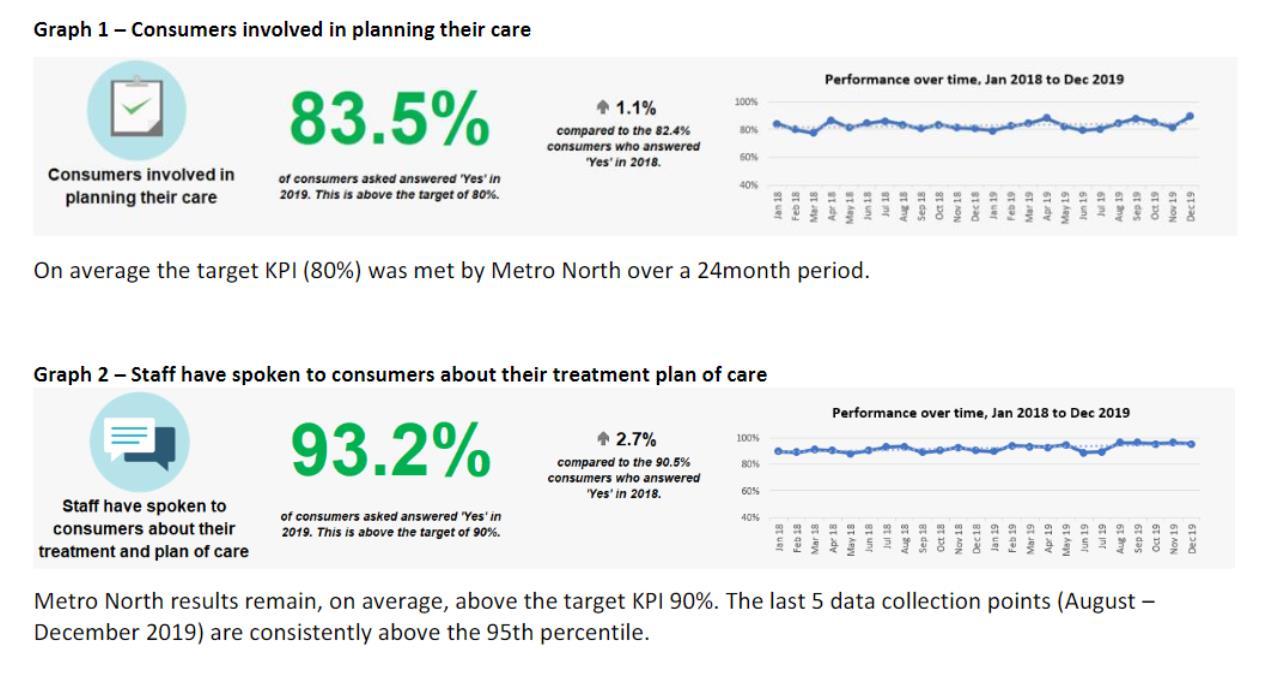
2. Effective Leadership
Clinicians are responsible for delivery of patient centred, safe and effective care and are actively engaged in safety and quality activities at each level of the organisation. Clinicians, including clinician managers and directors, lead the review and management of performance metrics, audits, morbidity and mortality reviews, consumer feedback and clinical outcomes.
In July 2018 Metro North HHS introduced a range of system wide strategies to reduce the number of HACs from both technical (accurate coding) and clinical perspectives including:
• HACs were to be monitored by Clinical Directorates through a purpose built Metro North HAC Dashboard.
• A report was developed for Metro North hospitals using benchmarked data published by the Health Roundtable (HRT) to identify good performance relative to each hospital’s peer group and areas for further improvement.
• Clinical governance committees established to identify, manage, monitor, review and escalate clinical incidents and risks, added incidents related to HACs to their agendas.
• Clinical governance committees also identified the strategies and initiatives implemented across Metro North to reduce HACs and improve patient care.
• Review of the accuracy of clinical coding and improvements made in the early identification by clinicians of complications that were not acquired within a Metro North healthcare facility.
• Policies, procedures, clinical practice and local guidelines, flowcharts, management plans, screening and assessment tools were reviewed to ensure healthcare workers identified patients at specific risk of healthcare associated complications.
• All Clinical Directorates identified, developed prevention and management strategies to coordinate healthcare needs for patients identified as ‘at risk’ of complications such as pressure injuries, falls, malnutrition and delirium.
The 23rd Annual ACHS QI Awards 2020 Page | 41 The Australian
on
23rd Annual ACHS Quality Improvement Awards 2020 REPORT
Council
Healthcare Standards
• Line managers committed to review both clinical incidents and HACs within their area and variances
3. Continuous Improvement
Four Year Benchmarked Trends



The Health Roundtables provides four year HAC trend charts that are benchmarked against each hospital’s peer group. The benchmarking uses percentiles to show relative performance. Percentiles are used to indicate the value below which a given percentage of the peer hospitals in a group of peer hospitals falls. For example, the 25th percentile is the value below which 25% of the hospitals may be found. Therefore, with a low HAC value representing good performance, a value at or below the 25th percentile would put a hospital’s performance within the best 25% of its peer group. Conversely, a value above the 75th percentile would put a hospital’s performance within the poorest performing 25% of its peer group.
and risks were to be reported to the respective clinical governance committee.
Thebelow charts showthatall MetroNorth facilitiesreduced the total number of HACs from the beginning of 2018/19. Whilst Caboolture and Redcliffe had been around or below the 25th percentile for some time, Royal Brisbane & Women’s Hospital (RBWH) had the most substantial reduction. The Prince Charles Hospital (TPCH) also improved performance from July 2018, declining to within the 75th percentile which was sustained for three of the four quarters. The Health Roundtable data also shows that the areas TPCH compares least favourably compared to its peers are respiratory complications, renal complications and cardiac complications. It should be noted that TPCH’s peer group are similar sized hospitals that do not necessarily have large Heart and Lung centres like TPCH.
The 23rd Annual ACHS QI Awards 2020 Page | 42 The
23rd Annual ACHS
Australian Council on Healthcare Standards
Quality Improvement Awards 2020
Health Roundtable Four Year Total HAC Trend by Hospital to June 30 2019
TPCH
RBWH
Caboolture
HRT data for Kilcoy hospital is not collected


Source: Health Roundtable, Hospital Acquired Complications Report, Jul 2018 Jun 2019

The 23rd Annual ACHS QI Awards 2020 Page | 43 The
23rd Annual ACHS Quality
2020
Australian Council on Healthcare Standards
Improvement Awards
Redcliffe
Evidence of Outcomes

Table 1: Number of Hospital Acquired Complications by complication 2017 18 and 2018 19
Surgical complications requiring unplanned return to theatre is reported locally and only had a reduction of one case down from 340 in 2017/18 compared to 339 returns in 2018/19 across MNHHS.
4. Striving for Best Practice
Attachment 1. Contains the benchmarked performance and improvement initiatives for each MNHHS wide HAC. Below is a sample of the performance benchmarking and initiatives of one HAC, provided as an example.
Pressure injury
Pressure injury HAC episodes declined by 34% in 2018/19 to 38 while the NWAU adjustment declined by 65%. Pressure injury HACs are the joint 10th most prevalent HAC group and accounted for less than 1% of Metro North’s NWAU
adjustment. RBWH has substantially reduced pressure injuries over the last financial year and Health Round table benchmarked data for Pressure injury per 10,000 episodes shows a declining trend for RBWH with Q4 2018/19 performance only slightly above the 25th percentile. Despite a small increase in pressure injuries at Redcliffe and Caboolture, Redcliffe was within the 25th percentile for its peer group while Caboolture was at the 50th percentile. TPCH has consistently performed well against its peers and was within the 25th percentile for 2018/19.
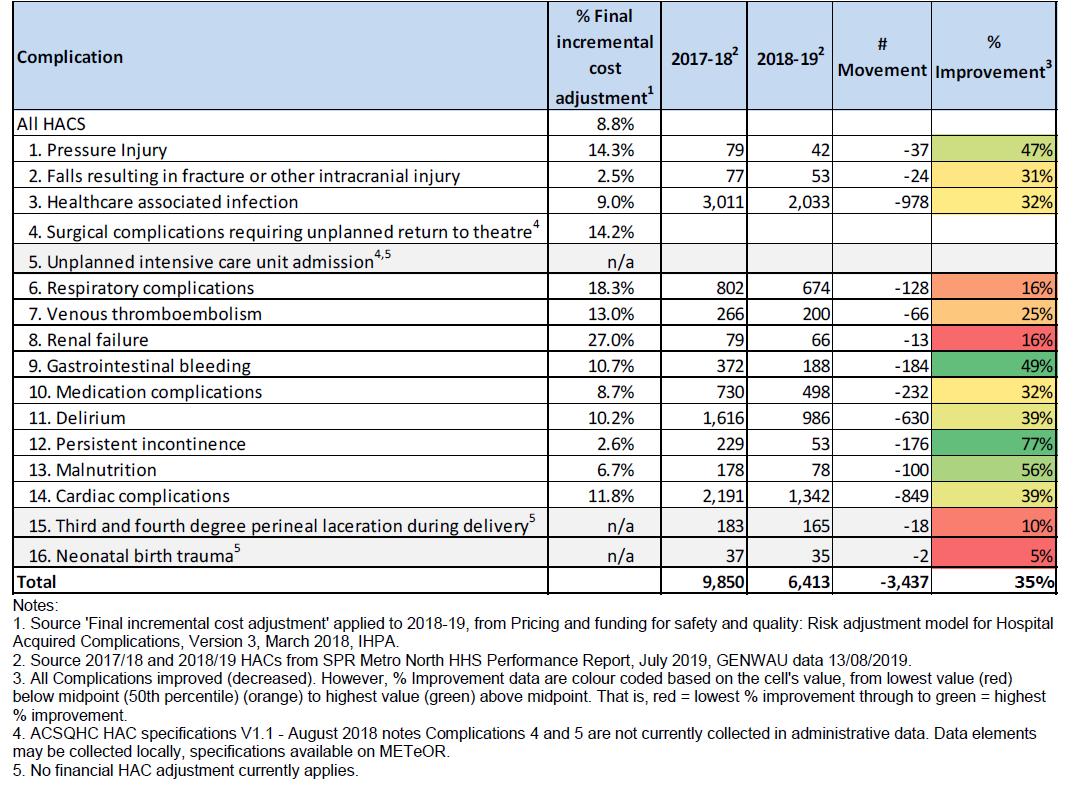
The 23rd Annual ACHS QI Awards 2020 Page | 44 The Australian Council on Healthcare Standards 23rd Annual ACHS Quality Improvement Awards 2020
Metro North Annual Comparison of Performance Pressure injury
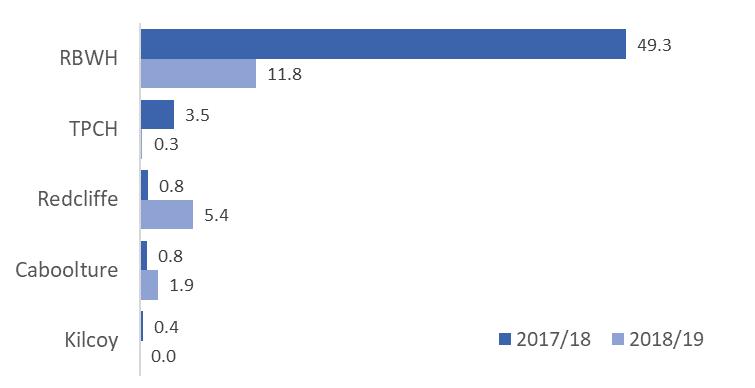
HAC Episodes by Facility 2017/18 – 2018/19

NWAU Adjustment by Facility 2017/18 – 2018/19
Source: DSS, downloaded 30/09/2019

HRT Trended Peer Comparison (Quarterly) July 2017 June 2019 Pressure injury per 10,000 episodes
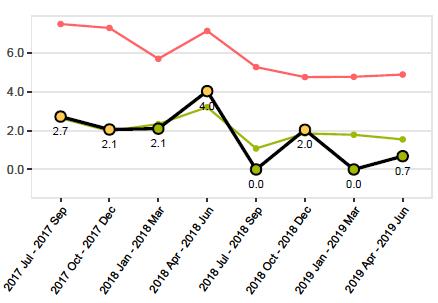
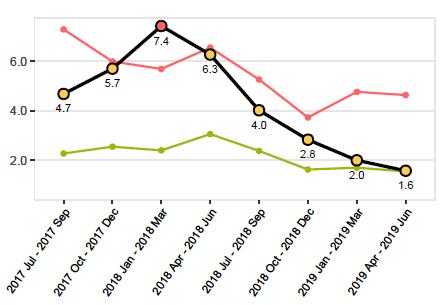
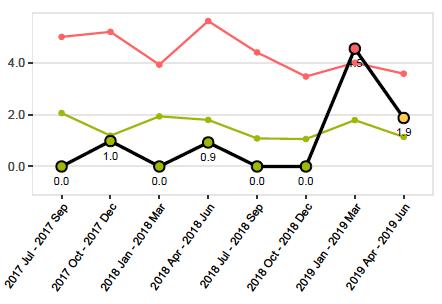
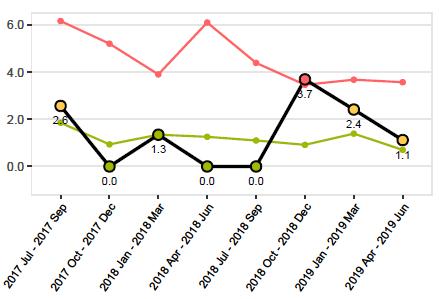
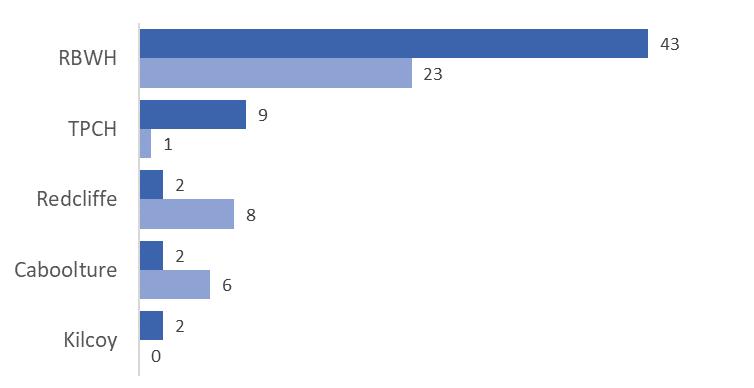
RBWH TPCH
Redcliffe Caboolture
Source: Health Roundtable, Hospital Acquired Complications Report, Jul 2018 Jun 2019
Strategies and initiatives to reduce rates of pressure injury
• Policies, procedures, clinical practice and local guidelines, flowcharts, management plans,
screening and assessment tools are in place for healthcare workers to identify patients at specific risk of pressure injuries.
The 23rd Annual ACHS QI Awards 2020 Page | 45 The
23rd
ACHS
Australian Council on Healthcare Standards
Annual
Quality Improvement Awards 2020
• All Clinical Directorates apply prevention and management strategies to coordinate healthcare needs for patients identified as ‘at risk’ of pressure injury.
• Clinical governance committees (pressure injury prevention and management committee) are in place to identify, manage, monitor, review and prioritise risks.
• Metro North Skin Integrity Dashboard provides high level visibility of hospital performance related to skin integrity data and pressure injury data recorded in the RiskMan system for Executives and Service Line Leaders.
• The ongoing pressure injury prevention and management is included on individualised ward quality improvement plans. Action plans have been developed in some Clinical Directorates. All cases undergo a formal chart review.
• As a result of a pilot study which identified that several mattresses were failing compression tests, RBWH undertook a facility wide audit of foam mattresses and implemented a mattress replacement process.
• Caboolture Hospital has produced a pressure injury prevention video for consumers, which is provided to them on iPads.
• Redcliffe Hospital has implemented a hospital wide improvement plan for the prevention of pressure injuries, which includes a thorough review of each clinical case, shared learnings and a hospital wide education plan to refresh processes for comprehensive skim assessments, pressure injury staging and pressure injury management.
• TPCH Health Information Services Team works closely with clinical staff to reconcile Pressure Injury details reported against RiskMan and Clinical Coding Data to ensure accurate reporting of pressure injuries.
• RBWH Health Information Services Team has worked with clinicians to reduce unspecified pressure injuries as this was the main area identified for improvement around documentation practices.
INNOVATION IN PRACTICE AND PROCESS
The innovations and strategies used to deliver the 35% improvement in HACs are included in Section C Striving for best Practice and in Attachment 1.
APPLICABILITY TO OTHER SETTINGS
Whilst the HAC learning of hospital have been shared within MNHHS and some across Queensland the principles and initiatives are likely applicable to any health service.
REFERENCES
Safer care saves money: How to improve patient care and save public money at the same time, Grattan Institute, August 2018.
Pricing and funding for safety and quality: Risk adjustment model for Hospital Acquired Complications, Version 3, March 2018, Independent Hospital Pricing Authority (IHPA)
Hospital Acquired Complications Information Kit, Australian Commission on Safety and Quality in Health Care.

The 23rd Annual ACHS QI Awards 2020 Page | 46
The Australian Council on Healthcare Standards 23rd Annual ACHS Quality Improvement Awards 2020

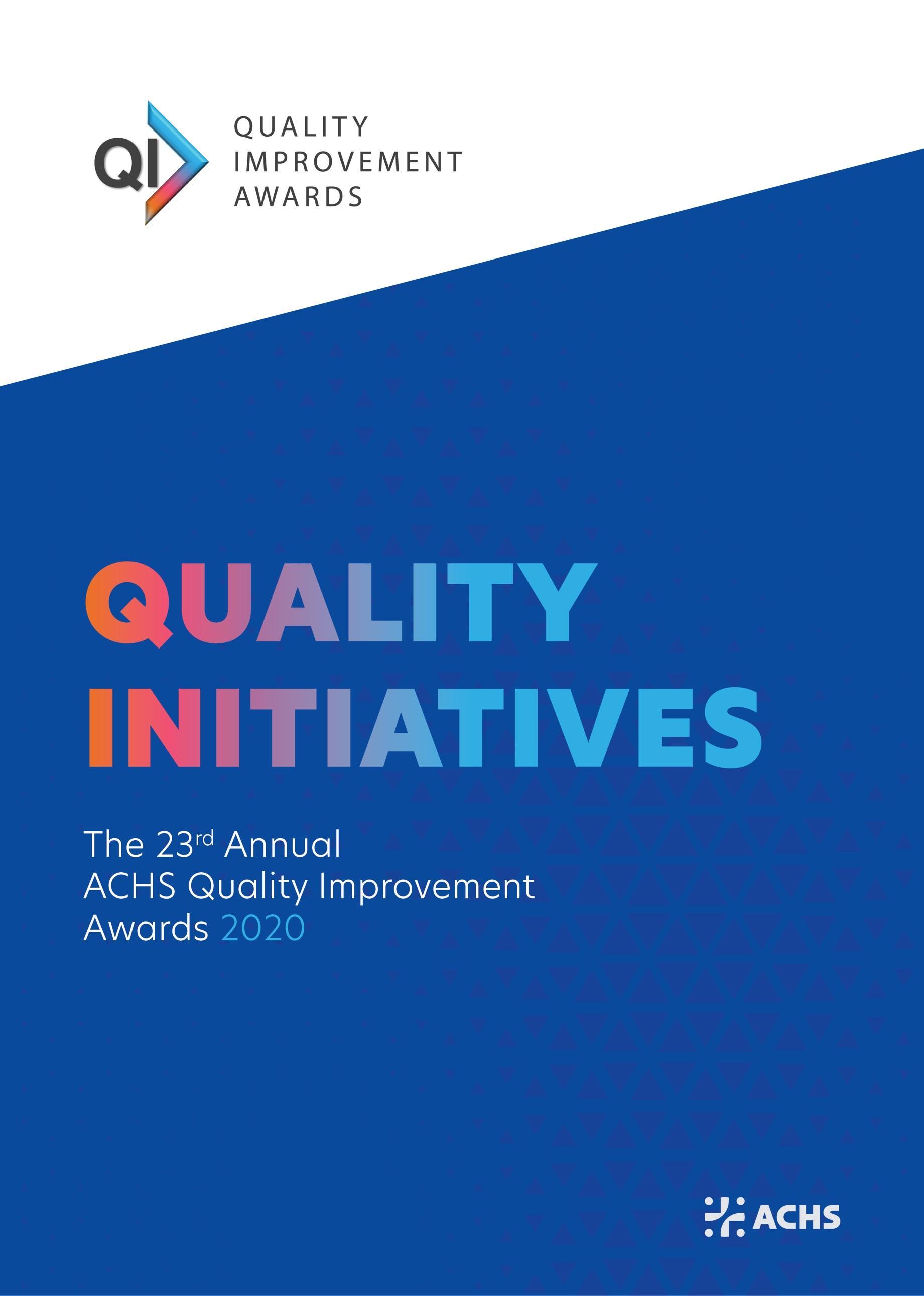











 THEDYNAMICAPPRAISALOFSITUATIONAL AGGRESSION AGGRESSIONPREVENTIONPROTOCOL NURSINGPRACTICEMANUAL
THEDYNAMICAPPRAISALOFSITUATIONAL AGGRESSION AGGRESSIONPREVENTIONPROTOCOL NURSINGPRACTICEMANUAL






















